Multitone Electronics PLC EKOPAG Alpha-numeric 2 way alarm and paging device User Manual System manual
Multitone Electronics PLC Alpha-numeric 2 way alarm and paging device System manual
Contents
- 1. Quick Guide
- 2. Handy Guide
- 3. System manual
- 4. Data sheet
System manual

www.multitone.com
EkoTek System Installation and Configuration
Manual
Survey
Installation
Configuration
Maintenance
EkoTek System Installation and Configuration Manual
9261-8173 issue: 8 Page i
© 2012 Multitone Electronics Plc
Table of contents
Table of contents...........................................................................................................i
Approvals .....................................................................................................................3
Compliance...............................................................................................................3
FCC and Industry Canada Statement of Compliance ..............................................3
WEEE Directive and Product Disposal.....................................................................3
System Overview .........................................................................................................4
1. EkoTek principles .................................................................................................5
2. Location reporting.................................................................................................6
3. Alarms ..................................................................................................................7
4. Location alarm ......................................................................................................7
5. Beacons................................................................................................................7
6. Two-way acknowledgement .................................................................................7
7. Two-way radio ......................................................................................................7
8. Frequency hopping...............................................................................................8
9. ESPA and TAP paging I/O ...................................................................................8
10. Configuration ......................................................................................................8
11. Network parameters ...........................................................................................9
12. Diagnostics and statistics ...................................................................................9
Components...............................................................................................................10
1. Hub .....................................................................................................................10
2. Repeater and mains-powered repeater..............................................................10
3. Solar repeater.....................................................................................................11
4. Call point and mains-powered call point.............................................................11
5. Call fob ...............................................................................................................12
6. Pager ..................................................................................................................13
7. Quad pager charging rack ..................................................................................14
Synchronised Ethernet Repeater ...............................................................................15
1. Overview.............................................................................................................15
Network design and survey........................................................................................17
1. Overview.............................................................................................................17
2. Prerequisites.......................................................................................................17
3. Placement rules..................................................................................................17
4. The survey unit ...................................................................................................18
5. How to survey.....................................................................................................21
Installation ..................................................................................................................22
1. Preparation .........................................................................................................22
2. Installing the hub and IP slave hub.....................................................................23
3. Installing the repeater, mains powered repeater and call point ..........................24
4. Installing the solar repeater ................................................................................28
5. Installing Synchronised Ethernet Repeater (SER) .............................................30
6. Installing the PPP modem ..................................................................................31
7. Installing the four-way pager charging rack........................................................37
8. Browser interface setup......................................................................................38
9. Main menus ........................................................................................................41
10. Maintenance menus .........................................................................................43
11. Configuration menus ........................................................................................47
12. SER overview ...................................................................................................49
13. Final checks......................................................................................................70
14. Configuring SERs .............................................................................................71
Synchronisation..........................................................................................................74
Appendix 1: Miscellaneous system messages...........................................................75
EkoTek System Installation and Configuration Manual
9261-8173 issue: 8 Page ii
© 2012 Multitone Electronics Plc
1. Personal security messages...............................................................................75
2. Pager response messages.................................................................................75
3. Maintenance messages......................................................................................75
Appendix 2: Specifications .........................................................................................76
Appendix 3: RS232 cable pin-outs for connecting the modem to the hub .................77
Appendix 4A: Overlapping system support ................................................................78
1. Overview.............................................................................................................78
2. Overlapping and mobile roaming systems .........................................................78
Appendix 4B: Channel allocation with SER ...............................................................80
1. Overview.............................................................................................................80
Appendix 5: Remote logging protocol ........................................................................81
1. Overview of logging ............................................................................................81
2. General formatting..............................................................................................81
3. Log examples .....................................................................................................83
Appendix 6: External system connections .................................................................85
Appendix 7: Over the Air upgrade..............................................................................86
Revision history and related documentation ..............................................................88
1. Revision history ..................................................................................................88
2. Related documentation.......................................................................................88
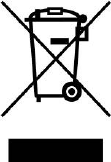
EkoTek System Installation and Configuration Manual
9261-8173 issue: 8 Page 3
© 2012 Multitone Electronics Plc
Approvals
Compliance
This product complies with the requirements of the EU Radio & Telecommunications
Terminal Equipment Directive 99/5/EC.
FCC and Industry Canada Statement of Compliance
This device complies with Part 15 of the FCC Rules and Industry Canada Standard
RSS 210.
Operation is subject to the following two conditions: (1) this device may not cause
harmful interference and (2) this device must accept any interference that may cause
undesired operation.
Unauthorised modification to this equipment will void the user's authority to continue
to operate the device within the scope of the Industry Canada and FCC Part 15
Rules.
A full technical specification for this product may be obtained from your Multitone
representative.
WEEE Directive and Product Disposal
At the end of its serviceable life, this product should not be treated as
household or general waste. It should be handed over to the applicable
collection point for the recycling of electrical and electronic equipment, or
returned to the supplier for disposal.
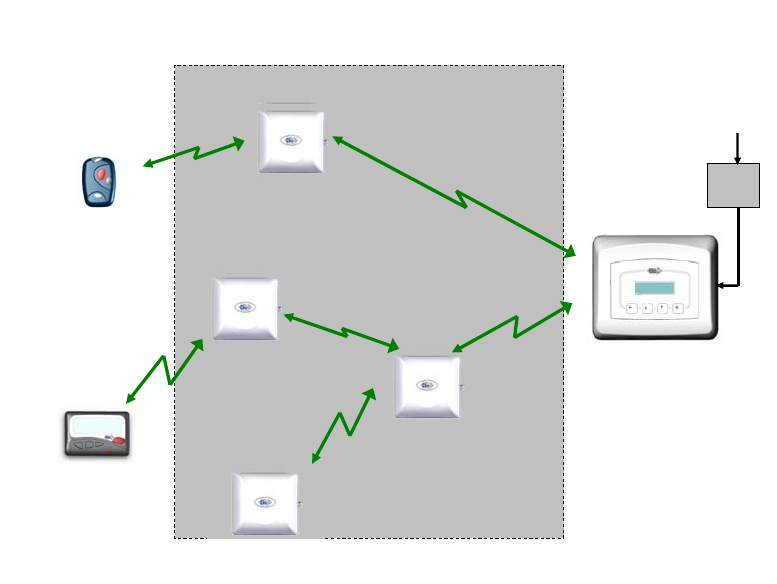
EkoTek System Installation and Configuration Manual
9261-8173 issue: 8 Page 4
© 2012 Multitone Electronics Plc
System Overview
EkoTek’s personal security system consists of mobile devices that send assistance
messages to other fixed or mobile devices, where the assistance message and
location of the caller are displayed:
Includes Personal
Security Alarm
Hub
Including Web Server
Repeater
Wireless Link
Call Fob
Pager
Repeater to Repeater
Distance Typically 10 to 15m
Repeater
Repeater
Repeater
Battery Powered
Power
Adaptor
AC
Messages are communicated via a backbone radio network, which makes use of
repeaters to relay messages around the network.
Due to the multi-hop nature of the backbone network, the physical shape and size of
the network is defined by the layout of the repeaters, which may be in three
dimensions e.g. covering multiple floors in a building.
EkoTek is truly wireless (only the hub needs AC power), making installation and
expansion very quick and easy.
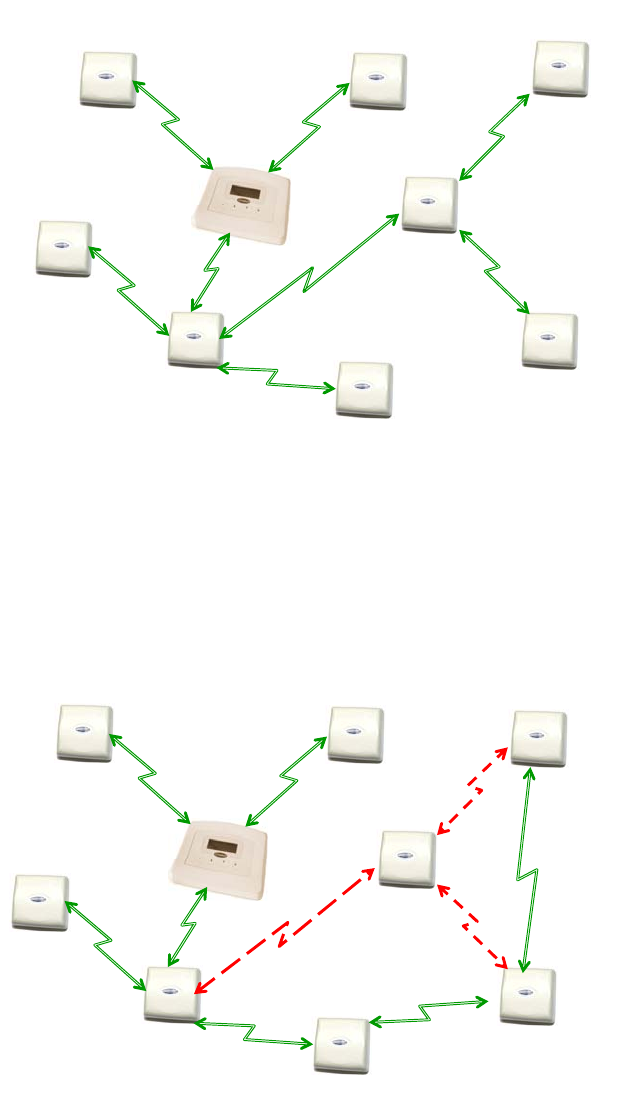
EkoTek System Installation and Configuration Manual
9261-8173 issue: 8 Page 5
© 2012 Multitone Electronics Plc
1. EkoTek principles
Each EkoTek product is a node that forms part of a self-organising radio mesh
network:
Node Node Node
Node
Node Node
Node
Node
Node
Each node in the network searches for links to nearby nodes, to form the network
mesh. Organising the network is an automatic function carried out by the nodes
themselves – configuration is not required.
As the network is self-organising, it is also self-repairing. Should a node (repeater)
fail, the network will automatically reconfigure around the failed node:
Node Node Node
Node
Node
Node
Node
Node
Node
Re-route
Re-route
The dimensions of the network are defined by the layout and distribution of repeater
nodes, the layout being arranged to meet the requirement, e.g. reception and public
areas of a hospital, accident and emergency department, or all floors of a building for
security guard lone-worker protection.
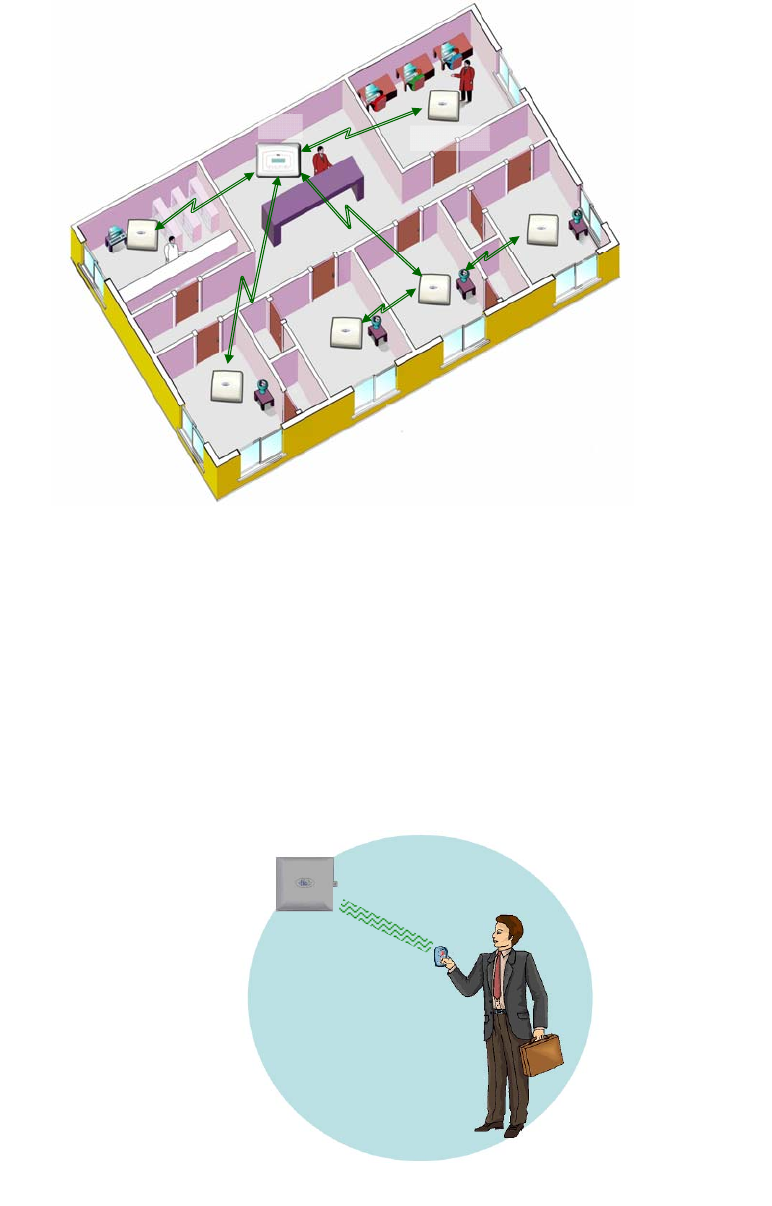
EkoTek System Installation and Configuration Manual
9261-8173 issue: 8 Page 6
© 2012 Multitone Electronics Plc
Sizeable networks can be easily built, due to the large number of repeaters
supported by EkoTek.
Repeaters are normally installed on walls and/or ceilings. By adding an enclosure
they can easily be installed outdoors. The hub is installed either on a wall or on a
desk, so that the display can be easily seen:
Hub Repeater
Hub and Repeaters automatically
form a mesh network
2. Location reporting
When a user raises an alarm signal, it is important to know the location of the user to
ensure that assistance arrives as quickly as possible.
EkoTek provides accurate location reporting, based on location signals sent out by
the repeaters:
Repeater
Call Fob
Location Signal
EkoTek System Installation and Configuration Manual
9261-8173 issue: 8 Page 7
© 2012 Multitone Electronics Plc
3. Alarms
A user may manually signal an alarm by pressing the red button on a pager or call
fob, or alarms may be triggered automatically for man down, dead man or location
alarms. When an alarm is triggered the user identification (name), location and alarm
type are included in the alarm message displayed on the hub and sent to pagers.
4. Location alarm
The location alarm feature allows pagers and call fobs to automatically raise an alarm
should the device wearer enter a location where the local repeater indicates an
unauthorised zone. Applications include ‘resident wander’, where an alarm would be
raised if a resident wandered into a zone where they were not expected or not
allowed, and ‘contractor/visitor’ location alarm where an alarm could be raised if a
person entered a part of the building that they were not authorised to access.
5. Beacons
Beacon signals are used to update a device with information of who its parent is.
The hub and all repeaters regularly transmit two types of beacon – system beacons
and location beacons. Location beacons generally have a shorter range than
System beacons. A repeater, pager or call fob can only ever have one parent at a
time. Every 1000ms the repeater transmits to the pager or call fob, which is then
updated with its location and will continue to receive subsequent beacons from the
repeater (its parent). If the pager stays within range of the location beacon the
location will be shown on the pager's display, ‘= [location name]’ (for example, ‘=
Conference Room 1’). If the pager goes out of range of the location beacon but can
still receive the system beacon, ‘- [location name]’ will be shown instead, where
[location name] is the name of the last location beacon received. When a pager or
call fob receives a new location beacon it picks up location information from the new
repeater and updates itself with the new location.
6. Two-way acknowledgement
Messages from external systems and maintenance messages are one-way
messages from the hub to the pager, whereas alarms generated by a user are two-
way. For peace of mind of the user, the acceptance of an alarm at the hub or a
pager by someone who will be coming to the aid of the user is signalled back to the
user by the call fob lamp and beeper changing their alert patterns, or by the pager
display indicating the status of the alarm.
7. Two-way radio
All EkoTek radio links are two-way, providing the ability to signal both to and from all
devices on the network.
Two-way radio provides the ability to quickly detect and correct any lost messages,
for example, when a message is relayed from one repeater to a second repeater, the
second repeater will acknowledge receipt of the message. If the first repeater does
not receive an acknowledgement it retransmits the message. This ability allows
EkoTek to function, even in environments where there is radio interference or poor
signal.

EkoTek System Installation and Configuration Manual
9261-8173 issue: 8 Page 8
© 2012 Multitone Electronics Plc
A further benefit of two-way radio is the ability to download configuration parameters
to all devices from the hub, using over-the-air programming. Devices do not hold
their own configuration, as this is sent by the hub upon request when devices are
powered up. Even pagers and call fobs have their configuration held at the hub,
making it unnecessary to recall mobile devices for configuration change, as all
updates are made centrally at the hub.
8. Frequency hopping
EkoTek radio links can be configured to operate on a fixed frequency, or to hop
across all 16 available frequencies. Frequency hopping increases the immunity of
EkoTek systems to radio interference. If a message is lost due to interference on a
frequency, the loss is immediately detected and the message retransmitted on the
next frequency in the hopping sequence.
Frequency hopping is especially useful where the local radio environment may be
unknown, or subject to change. EkoTek’s combination of message loss detection,
automatic message retransmission and frequency hopping, makes for a very robust
radio infrastructure.
9. ESPA and TAP paging I/O
In addition to the in-built support for EkoTek two-way pagers, the hub provides the
ability to connect the EkoTek system to external systems via a one-way paging
interface. This allows the EkoTek system to either receive or to send messages to a
pre-existing one-way paging system.
The hub paging interface can be selected from ESPA or TAP as an input or output
through Port A and by using Port B TAP or ESPA input only. This allows EkoTek to
be used as a paging system, e.g. for connection to a nurse call system or to send
messages to a pre-existing one-way paging system.
10. Configuration
All configuration of the EkoTek system is performed via web pages stored on the
EkoTek hub. Access to this web server is either via the 10/100Base-T Ethernet port
or using PPP via an RS232 serial port. Configuration for all devices is held on the
hub and downloaded to each device at power-up.
The hub defaults allow a new system to operate ‘out-of-the-box’, only requiring the
location names for the repeaters and user names for the mobile devices to be
entered on the hub’s web server configuration page.
Each device has its own unique factory set serial number for identification, but there
is no factory programming of the devices. The hub configuration set for the devices
during installation defines whether device options (e.g. the man down alarm) are
enabled or not.
EkoTek System Installation and Configuration Manual
9261-8173 issue: 8 Page 9
© 2012 Multitone Electronics Plc
11. Network parameters
An EkoTek system controlled by a single hub is able to support up to 500 devices.
See Appendix 2: Specifications (page 76) for maximum numbers for each type of
device.
The network radio channels can be configured using the hub web server interface,
with up to 16 channels being available for simultaneous use by a single EkoTek
system. The default configuration is for all EkoTek devices to use channel 15. See
the Multitone document ‘Example EkoTek System Configurations’ for more
information on special configurations.
A single EkoTek radio channel can support up to 90 repeaters, but a limitation of 70
per channel is recommended to allow for dynamic reconfiguration (silent parent
swapping). The repeaters can be configured in any physical deployment, as long as
each repeater is able to establish and maintain a suitably strong signal with a nearby
repeater that has a path back to the hub.
12. Diagnostics and statistics
Each EkoTek device collects statistics on network performance. These statistics are
regularly sent to the hub and can be viewed using the web server.
Failure (e.g. loss of network coverage) and battery low indications for EkoTek
devices are displayed on the status screen of the web interface; these messages are
also reported on the hub and/or pager displays if the option to do this is configured.
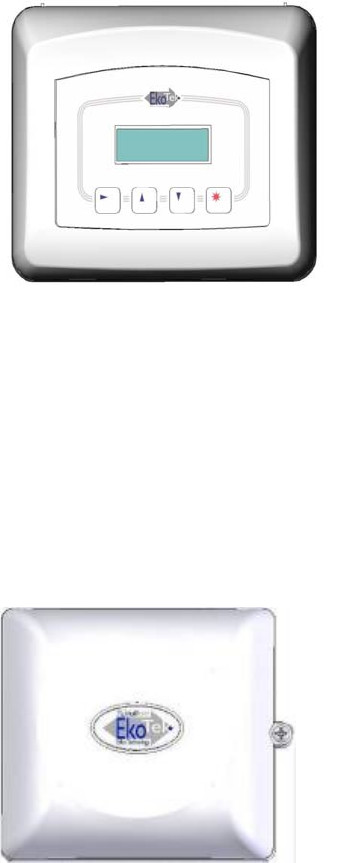
EkoTek System Installation and Configuration Manual
9261-8173 issue: 8 Page 10
© 2012 Multitone Electronics Plc
Components
1. Hub
The hub is the central device in the mesh
network. All communications pass to and
from the hub; ideally it should be installed
near the physical centre of the network, but
it can be located anywhere within the
network.
A hub display shows alarm messages in a
similar way to a two-way pager.
For configuration, a PC running a web
browser is connected via Ethernet to the
web server running on the hub.
Other connections on the hub are for alarm relay contacts, external systems, web
access using PPP, and power input. Internal rechargeable batteries allow the hub to
function in the event of an AC power failure.
For more information on front panel operation of the hub see 9621-8276 EkoTek hub
user guide.
2. Repeater and mains-powered repeater
Repeaters form the backbone of the self-configure
radio mesh network. Each repeater automatically
forms links to nearby repeaters, to allow
messages to pass across the backbone. Two
screws hold the repeater to the ceiling or wall.
Two internal alkaline D size batteries power the
repeater. The battery voltage is continuously
monitored and reported to the hub and/or pagers,
raising an alarm should the voltage fall below set
levels, indicating that the repeater batteries
require replacement.
The mains powered repeater is functionally similar but provides terminals for wiring to
an external low voltage DC supply and contains an internal rechargeable battery
pack for battery backup in case of supply failure.
Repeaters also transmit location beacon signals, which are used by the mobile
devices to determine their location, which is sent when assistance messages are
generated.
Repeaters may form the mesh network in 3 dimensions, with repeater radio links able
to pass through walls and ceilings if necessary.
By default, all repeaters operate on the same radio channel as the hub. This is the
default configuration used by small systems.
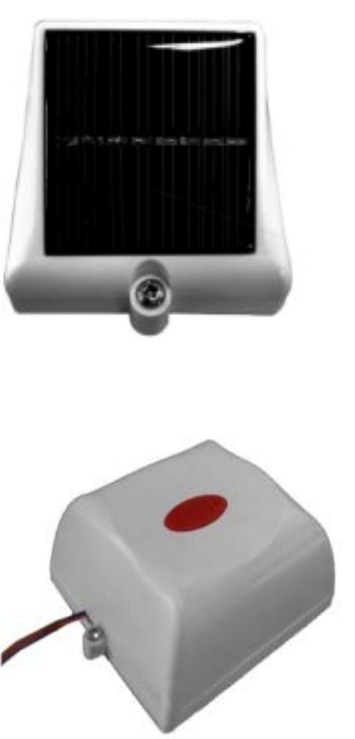
EkoTek System Installation and Configuration Manual
9261-8173 issue: 8 Page 11
© 2012 Multitone Electronics Plc
However, where there is a need to force repeaters to make links to other specific
repeaters, (e.g. when a building-building link is required or when using Ethernet
repeaters), repeaters can be configured through the hub to operate only on specific
channels.
Battery replacement for the repeater is quickly achieved by sliding the repeater from
the backing plate and lifting out the old batteries. No tools are required for this. An
optional locking screw can be inserted where necessary to help prevent tampering
with the repeater, for example, where the repeater is installed in a public
environment, within reach of passers by.
Repeaters continually test links to adjacent repeaters, detecting link failures and
automatically searching for and establishing new links should one fail.
Network moves and/or expansion are achieved by moving or adding new repeaters
where required, making any network changes rapid and cost effective.
3. Solar repeater
The solar repeater is based on the standard
repeater, with the additional functionality of power
obtained from an integral solar panel with a
rechargeable battery acting as a power reserve in
periods of low light. It can therefore operate in full
sun or shade provided that it receives enough
solar radiation to charge the battery sufficiently for
the unit to continue to operate in periods of low
light.
The solar repeater is dust and water resistant to
IP65 and UV and corrosion proof, and can be
mounted on a wall or pole.
4. Call point and mains-powered call point
The call point allows alarms and assist calls to
be raised by a red button on the front of the
unit or an external closing contact input.
A call point can be used to connect to
equipment that has a closing contact (a
simple switch such as a ceiling mounted pull
cord) to signal an alarm.
The assist message is configurable separately
for the red button and external contact input.
The call point has an internal sounder
(configurable on/off) to indicate call state.
The red button can be configured as either:
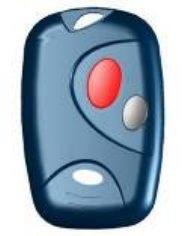
EkoTek System Installation and Configuration Manual
9261-8173 issue: 8 Page 12
© 2012 Multitone Electronics Plc
1. Disabled.
2. Single press raises alarm.
3. Double press raises alarm.
A long press of the red button always clears an alarm raised by the red button or the
external alarm contact.
The mains powered call point is functionally similar but provides terminals for wiring
to an external low voltage DC supply and contains an internal rechargeable battery
pack for battery backup in case of supply failure.
The call point can also be used as a repeater while still retaining call point
functionality. For mounting positions where the unit is at body height this is not
recommended, as the quality of link that the call point can offer will degrade when
someone stands near or in front of the unit. This may cause devices communicating
through the call point repeater to lose contact with the network. For high positions
such as operating in conjunction with a ceiling pull cord this should not be a problem.
A situation where repeater operation may be acceptable if the unit is at body height is
to allow the unit to be a repeater for mobile devices only. This can be achieved by
setting the call point’s ‘Downstream channel’ to a channel that other repeaters cannot
use as an ‘Upstream channel’.
5. Call fob
The call fob allows assistance calls to be raised, using the
location signals from repeaters for accurate location
determination. The call fob also supports dead man, man
down and location alarms [explained in ‘Configuration’
section].
The configuration of the call fob is downloaded from the hub
when the call fob is powered up.
The selection of the call fob options is by hub configuration.
All call fobs are physically identical and support the same features (if enabled at the
hub).
An LED, buzzer and vibrate motor are contained within the call fob and are used to
indicate the call status. These change when a call is accepted by a remote user
using the hub or a pager. Indication of ‘assistance on its way’ is signalled in this way.
An AAA size battery powers the call fob. Either rechargeable NiMH or disposable
alkaline batteries may be used. Note that rechargeable batteries cannot be charged
in the call fob; the battery will have to be removed and placed in an external charger
when charging is required.
For further information see 9621-8277 EkoTek call fob user guide.
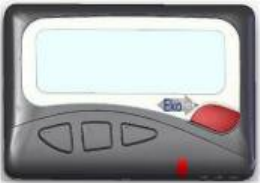
EkoTek System Installation and Configuration Manual
9261-8173 issue: 8 Page 13
© 2012 Multitone Electronics Plc
6. Pager
The pager has the following key functions:
Display of and response to assistance calls from
other EkoTek devices
Display of paging messages created using the
hub’s web server or an external system
Raising assistance calls in a similar manner to the
call fob
Snatch cord operation (later models only)
For further information see 9621-8275 EkoTek pager user guide.
EkoTek’s two-way radio network provides message interchange between devices, for
example, when a call fob raises an assistance message this is displayed on the hub
and the pagers. A pager or hub user can then accept the call, which is signalled
back to the call fob and indicated to the user by a change in the LED and beep
pattern being emitted by the call fob during the assistance call.
Paging messages can be generated either via the hub web server or an external
system. Web server-originated pager messages can be configured to show delivery
and request a ‘Yes/No’ response (only from EkoTek pagers with this two-way paging
function); simple task management systems can be easily created.
In a similar way to call fobs, pagers are able to generate assistance calls using the
red assistance button on the pager, the inbuilt man down or dead man functions, or
location alarms. A pager can therefore function as both an alarm unit and a display,
eliminating the need for users to carry both types of unit.
An AAA size battery powers the pager. Either rechargeable NiMH or disposable
alkaline batteries may be used. Charging contacts on the pager are used when the
pager is inserted into a charging rack.
Later pager models also have a snatch cord that is inserted into a socket on the body
of the pager. The pager generates personal security assistance calls when the
snatch cord is pulled and disconnected from the body of the pager if enabled. On
these models the snatch cord can be replaced with a blanking plug if this functionality
is not required.

EkoTek System Installation and Configuration Manual
9261-8173 issue: 8 Page 14
© 2012 Multitone Electronics Plc
7. Quad pager charging rack
The quad pager charging rack charges up to 4 pagers at one
time in the rack, with a maximum charge times of 12 hours to
charge a pager battery to 50% of its capacity.
The pager reports charging in its usual status report. An extra
report is generated when a pager enters or leaves the charger
so the hub can update its status quickly.
When a pager reports its battery status as charging, this is
shown on the device status display.
Man down and dead man alarms are automatically disabled
when a pager is inserted into the charging rack.
When a pager is installed in a charging rack, a user-
configurable feature allows the pager to be set to receive or
ignore messages, allowing the pager to continue to function in
the charging rack if required.
The standard EkoTek PSU is used as the rack PSU and can be
used to power up to two charging racks.
Note: The pager must be fitted with a NiMH rechargeable cell when used in a
charging rack. Use of the charging rack with other types of cell may damage the
pager.
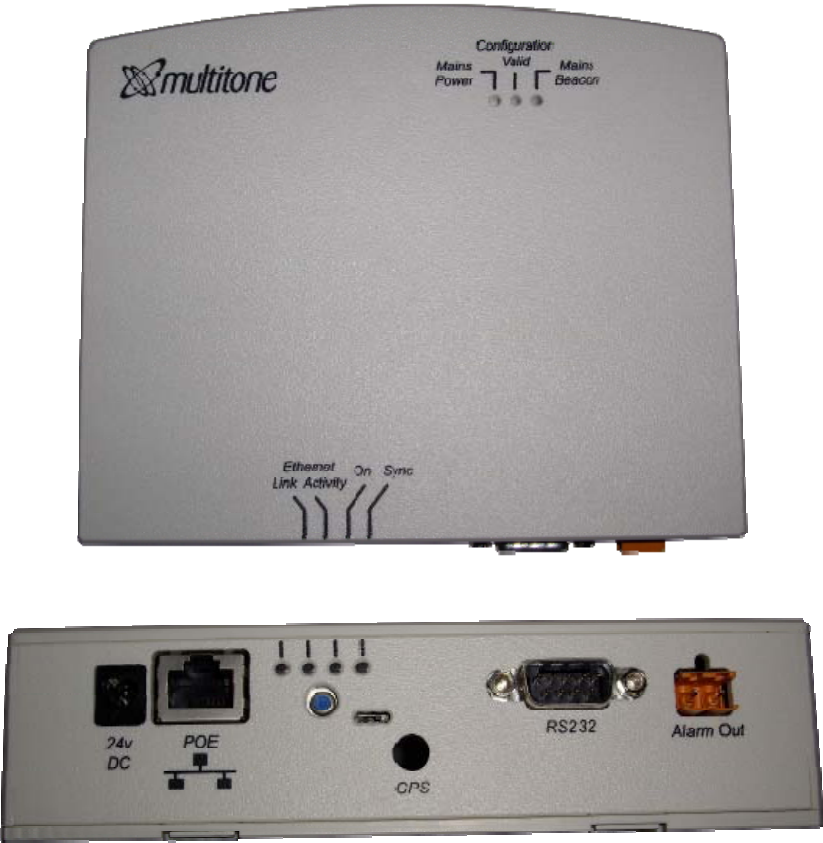
EkoTek System Installation and Configuration Manual
9261-8173 issue: 8 Page 15
© 2012 Multitone Electronics Plc
Synchronised Ethernet Repeater
The Synchronised Ethernet Repeater may simply be thought of as a repeater that
connects through the customer’s LAN.
1. Overview
The Synchronised Ethernet Repeater (SER), acts in the same way as a normal
repeater. It provides radio coverage and location information in a similar manner to a
standard repeater. However, the most important aspect of the Ethernet Repeater is
that it provides synchronous radio coverage over potentially wide areas. The SER is
a powerful new way to obtain synchronised radio coverage across large installations.
The upstream is connected to the hub via the LAN rather than as a radio link in the
standard repeater.
EkoTek System Installation and Configuration Manual
9261-8173 issue: 8 Page 16
© 2012 Multitone Electronics Plc
The synchronous aspect should not be overlooked nor misunderstood – this is
probably the most significant aspect of the SER.
When correctly configured, synchronised radio coverage is crucially important and
supports the following functionality in EkoTek installations:
1. Replaces long chains of repeaters - linking between buildings would
previously have required chains of repeaters to be set up.
2. Provides robust and reliable radio coverage – more effective in multi-floor
environments because the radio path back to the hub is via LAN.
3. Up to 8 SERs can be connected to a single hub with one SER being master
for system timing.
4. Allows the EkoTek hub to be remotely located on the customer’s LAN –
previously required to be at the centre of the network coverage but can now
be located in a Security Control Centre in a remote location.
5. Provides synchronised radio timing with other SER via the LAN.
6. Without synchronisation fixed networks could possibly interfere with each
other and mobile devices will not necessarily detect new networks.
Note: A stable and reliable customer LAN is essential when using SERs in the
System.
EkoTek System Installation and Configuration Manual
9261-8173 issue: 8 Page 17
© 2012 Multitone Electronics Plc
Network design and survey
1. Overview
The survey is used to assess the number of repeaters required and best locations. It
is suggested that the surveyor reads the ‘System Overview’ section (page 4) to
become familiar with the basic principles of operation.
2. Prerequisites
Two survey pagers (2WSU)
Site plan
3. Placement rules
Each repeater connects to the hub, either directly or via another repeater. The
number of repeaters required depends on the size and layout of the building and the
consistency of the radio coverage.
The EkoTek hub and repeaters must not be installed in areas where explosive gas or
dust products may be present. Devices must be protected from liquids, extreme
temperatures and strong magnetic fields. Do not install in places where they will be
exposed to strong sunlight or electromagnetic interference.
Hub
The hub should be placed in an area such as a control room or reception desk
where it is possible to monitor the display when required. Other considerations
are to minimise the number of hops required for any repeater to connect to the
hub; it is better if possible that the hub be located at the centre of the network,
unless using SERs. The hub must be located near an AC mains socket outlet
and an Ethernet connection; it should also be borne in mind that connection via
a modem link to the telephone network may be needed, so access to a
telephone socket would also be necessary. It is important that there are
multiple repeaters around the hub to ensure multiple paths to the rest of the
network and overcome any possible ‘people blocking’ of the hub.
Repeaters
Ideally repeaters should be spaced 10-15 metres apart. They should be no
closer together than 6 metres, except where there is a structural barrier
sufficient to attenuate the radio signal, such as a wall between repeaters. The
maximum range is 20 metres, but placing repeaters at this distance should be
avoided if possible, as any degradation of the radio path may result in the loss
of connection between repeaters.
For the positioning of a solar repeater see ‘Solar repeater positioning’ (page
28).
Multi-storey buildings
EkoTek can be used in multi-storey buildings, where the floors are of concrete
construction. The concrete floor provides sufficient attenuation of the radio
signal to ensure that the pager or call fob’s location is reported on the correct
floor. In wooden floored buildings, the pager may pick up a beacon from the
EkoTek System Installation and Configuration Manual
9261-8173 issue: 8 Page 18
© 2012 Multitone Electronics Plc
floor above or below, giving an inaccurate location for the device. Careful
positioning of repeaters is therefore required when wooden or mezzanine floors
are in use if location is important.
In order to establish which floor the pager or call fob is on, it is important that
repeaters are placed at the entrances to the bottom and top of stairwells. The
actual placement of the repeater may not necessarily be in the stairwell itself,
but may be in a room leading to the stairwell, in order to provide sufficient radio
separation between repeaters.
Corridors
In long corridors it may be prudent to place a repeater in the middle of the
corridor as well as at the ends, to ensure robust radio connection in the mesh.
Room placements
If locating in individual rooms, place the repeater as central to the room as
practical. Placing it on the edge of the room may allow sufficient strength of
location signal to pass through the wall to be seen as a beacon by a pager or
call fob in the adjacent room or corridor.
It is however highly unlikely that the signal would pass through more than one
wall.
In large rooms such as warehouses, it will be necessary to place more than
one repeater to ensure adequate radio coverage.
Between buildings
If buildings are sufficiently close together, radio signals may pass between
them. However, if for example a vehicle passes between the buildings, it may
cause signal deterioration and the repeater to lose contact with its parent. For
this reason on a multi-storey building, it would be better to force the repeaters
on the first floor to form the link between buildings. This is achieved by setting
the downstream link of the parent on the first floor of one building to be a
specific channel and the upstream link of the repeater on the first floor of the
adjacent building to be also the same channel (unless using SERs).
Mesh structure
A repeater can only have one parent at a time; however, the principle of a
mesh network is that if a connection fails the repeater can search for an
alternative parent in order to rejoin the network. If it is unable to locate a
suitable new parent, its portion of the network will be broken. It is therefore
important to ensure that any repeater has multiple potential paths to the hub.
4. The survey unit
The survey unit is designed to assist in the placement of repeaters and aid in trouble
-shooting the network. It has several modes of operation, described below. The
▲▼buttons scroll through the menus. A long press on the button will switch the
survey pager on and off.
When taking measurements always hold the pager by the left hand side to avoid
masking the signal; the pager’s antenna is located on the right hand side. Also avoid
placing your body between the pager and the measured device, as this will attenuate
the signal.
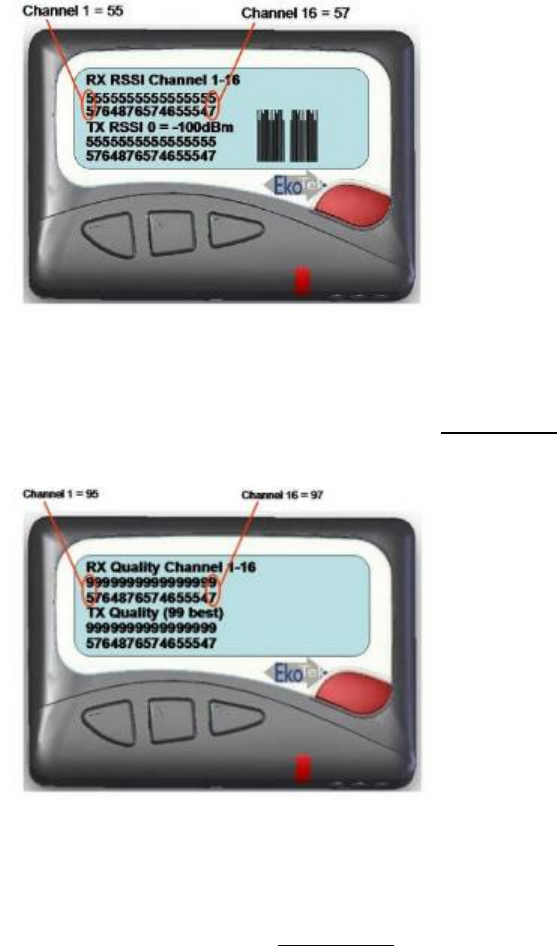
EkoTek System Installation and Configuration Manual
9261-8173 issue: 8 Page 19
© 2012 Multitone Electronics Plc
Note: The survey pager is continuously transmitting a signal and its battery life is
therefore short. To avoid unnecessarily draining the battery, switch off and/or remove
the battery when not in use.
Survey pager modes
RSSI
This screen indicates the signal strength for each channel in both the Rx and
Tx paths. The measurement for each channel is displayed as a vertically
stacked number. Ideally the RSSI should be 30 or above.
Quality
This screen indicates the quality for each channel in both the Rx and Tx paths.
The measurement for each channel is displayed as a vertically stacked
number. The range of reported values is 0 to 99 with 99 being the best quality.
Ideally the quality should be 90 or above.
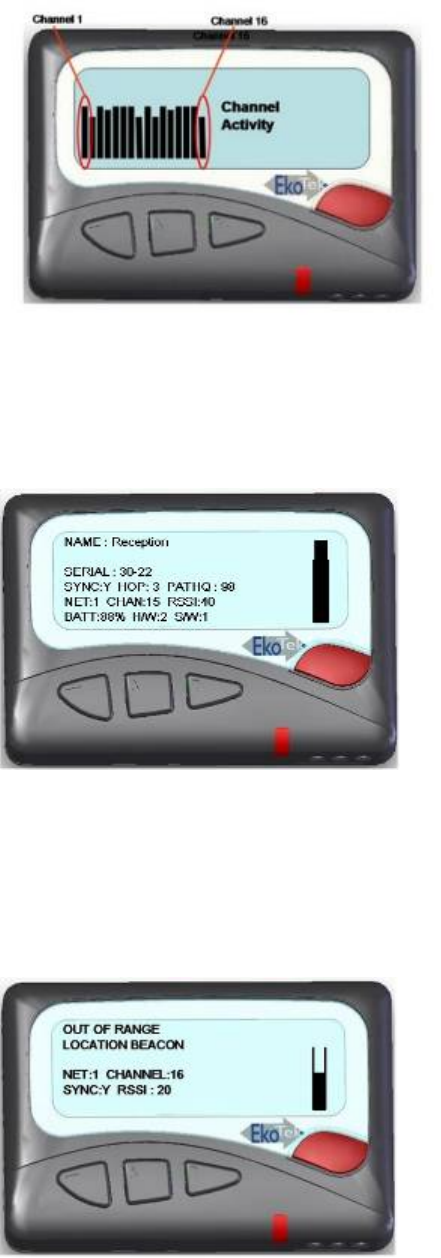
EkoTek System Installation and Configuration Manual
9261-8173 issue: 8 Page 20
© 2012 Multitone Electronics Plc
Network monitoring mode
Channel activity
This shows the activity on each channel and is useful in determining the
amount of Wi-Fi activity on the system. Note: Channel activity can take some
time to be detected, so run for at least 1 minute.
Repeater information
This screen shows information about the repeater that the survey pager is
connected to. The bar display shows the strength of the repeater’s beacon
received by the survey pager relative to the programmed repeater location
range. The RSSI number is an indication of the signal strength of the
repeater’s parent as received at the repeater.
Out of range location beacon
This screen displays information about nearby repeaters. The bar display
shows the strength relative to the programmed repeater location range.
EkoTek System Installation and Configuration Manual
9261-8173 issue: 8 Page 21
© 2012 Multitone Electronics Plc
5. How to survey
Decide on the location for the hub. It is desirable to mount the first repeater close to
the hub location since radio transmissions can be affected by people close by.
Ask the customer which locations are critical for accurate call location reporting and
mark on the plan those places as locations for repeaters. It may be every room, a
defined area or different floors. In very large rooms use more than one repeater.
Also mark on the plan the positions for repeaters at the top and bottom of all
stairwells, to allow location tracking between floors.
The customer may also want to have a location change when persons leave a critical
area. If so, mark repeaters on the site plan at the exit of those critical areas.
When all the likely places for repeaters have been marked, inspect the site plan to
estimate if the distance between repeaters exceeds the 10-15 metre maximum
separation rule. If there appears to be a long gap between repeaters, consider if
there are repeaters on the floor above or below that can form a path for the network.
If a repeater appears to be isolated, use survey pagers to check the RSSI. Place a
pager at the repeater and measure the RSSI at its nearest neighbour. Remember its
nearest neighbour may be on a different floor. If the nearest neighbour is the other
side of a thick wall, other marked locations may provide a more viable route. If in
doubt it is best to place in-fill repeaters, as the more repeaters in a network the more
robust the network is liable to be. If the RSSI is below 20, then consider placing
another repeater in between.
EkoTek System Installation and Configuration Manual
9261-8173 issue: 8 Page 22
© 2012 Multitone Electronics Plc
Installation
1. Preparation
Prerequisites
Prior to installation, the following items are needed:
Site plans with position of the hub and all the repeaters clearly marked
An AC mains socket outlet for the hub
An Ethernet connection to the customer LAN for the hub
A working telephone line and AC mains socket for the PPP connection
(if required)
A line for external ESPA or TAP system connection (if required)
Identify which PC is to be used for admin access and log file downloads
If installing SERs they will need an AC mains socket outlet plus
connection to the customer’s LAN
Tools recommended
Pozidriv screwdriver
Screwdriver with 2.5mm blade
Stepladder
Cordless drill
5mm masonry bit
6mm masonry bit
Metric rule
Laptop with Ethernet port
Ethernet patch cable
Call fob and pager from customer system
Survey pager
Equipment required
EkoTek hub with AC power supply unit
If modem access to a telephone link is required then use current
recommended modem with AC supply unit and a RS232 (proprietary)
connecting lead. See Appendix 3: RS232 cable pin-outs for connecting
the modem to the hub
EkoTek repeaters: quantity as required by survey. It is also suggested
that spare repeater/s are supplied, in case there is a need for infill that
was not detected on the survey (Ethernet repeater/s as required)
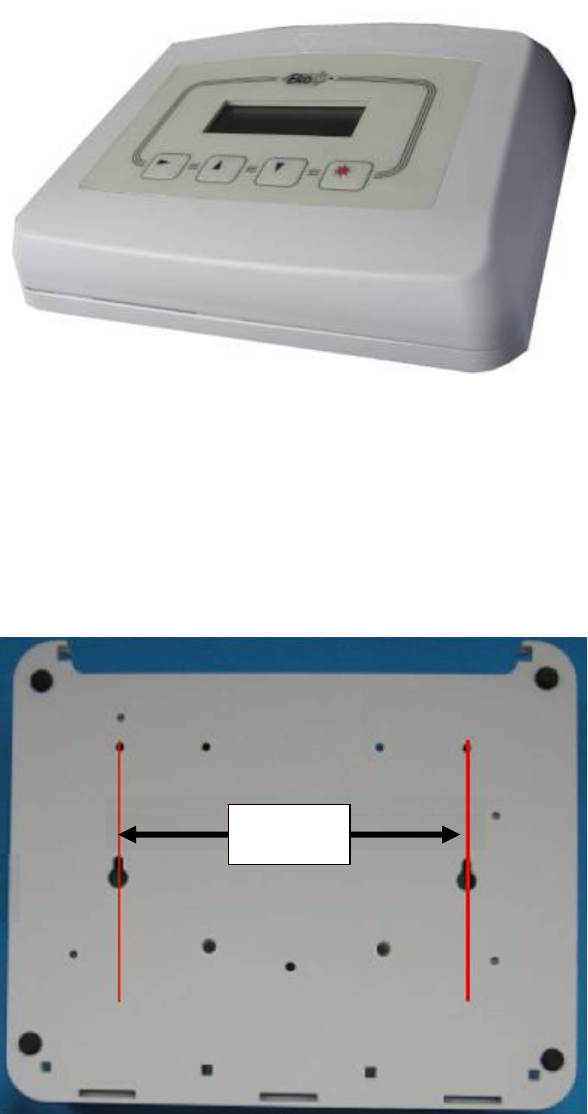
EkoTek System Installation and Configuration Manual
9261-8173 issue: 8 Page 23
© 2012 Multitone Electronics Plc
2. Installing the hub and IP slave hub
The hub can be freestanding on a desk, or wall mounted using the screws provided.
To remove the cover, depress the two protruding plastic tabs and separate the top
from the back plate.
Wall mounting
Mark the position of the screws on the wall. The two screws should be spaced
precisely 120mm apart, as shown in the diagram of the back plate below:
Drill two holes with a 5mm masonry bit to a depth of 25mm.
Insert the wall plugs and screw the screws. Leave 7mm of the screw
protruding. (Note: Screws and plugs not provided).
Locate the screw heads in the holes in the back-plate and pull the unit down to
lock into place.
120mm
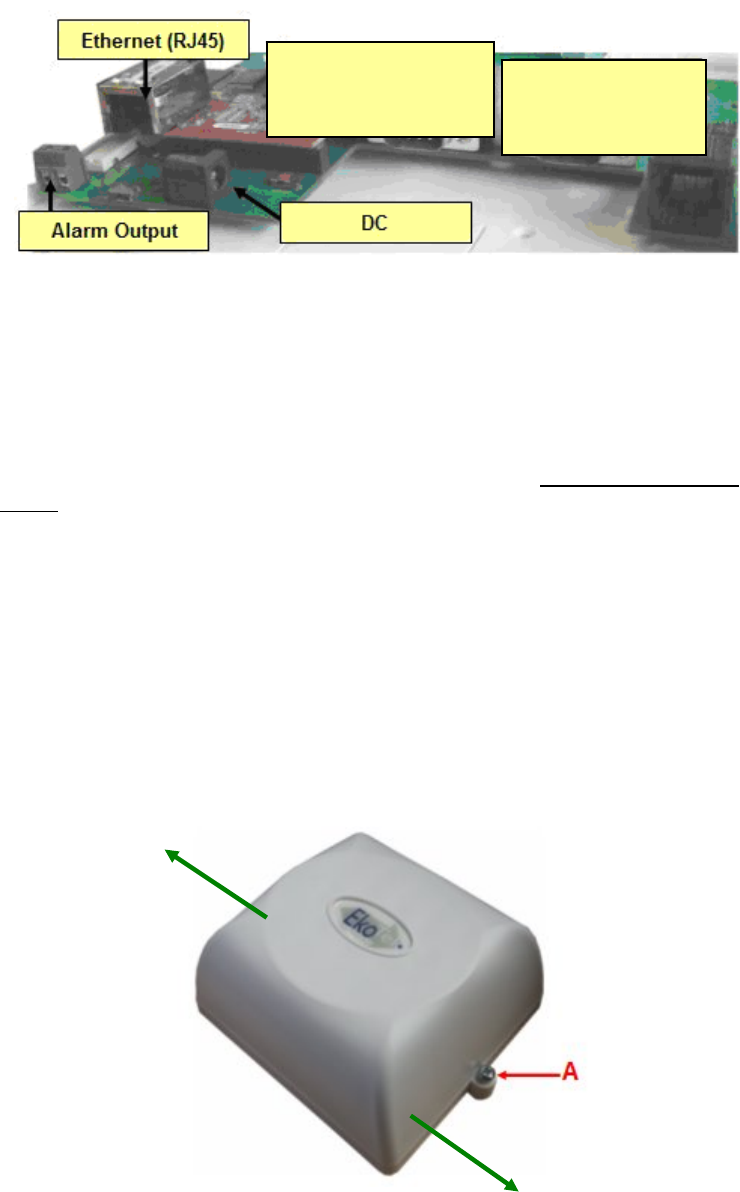
EkoTek System Installation and Configuration Manual
9261-8173 issue: 8 Page 24
© 2012 Multitone Electronics Plc
Interface connections
Plug in the AC to DC power adapter provided with the hub.
Plug in the Ethernet patch lead to connect to the LAN or PC. See ‘Connecting
the hub to the PC using Windows XP’ (page 41).
If an external alarm is to be activated from the hub, connect a pair of wires from
the alarm output shown in the interface connections diagram. The alarm output
is a simple make/break contact and can be used to operate a customer
provided alarm relay. This is not designed to provide a direct contact for AC
mains operated equipment.
Connect the DB9 port A connections to the customer's paging system if
required. The connection cable should be as specified by the paging system.
A PPP connection can be made after the modem has been set up via port B.
See ‘Installing the PPP modem’ (page 31) for further details.
3. Installing the repeater, mains powered repeater and call
point
Mounting the repeater or call point (incl. mains powered variants)
Remove the back plate from the device by removing screw A and sliding the
top and the base in opposite directions as shown by the green arrows. The
standard repeater is shown in the diagram; the call point and mains powered
devices are opened in the same way.
Port A -
(DB9) Port B -
(DB9)
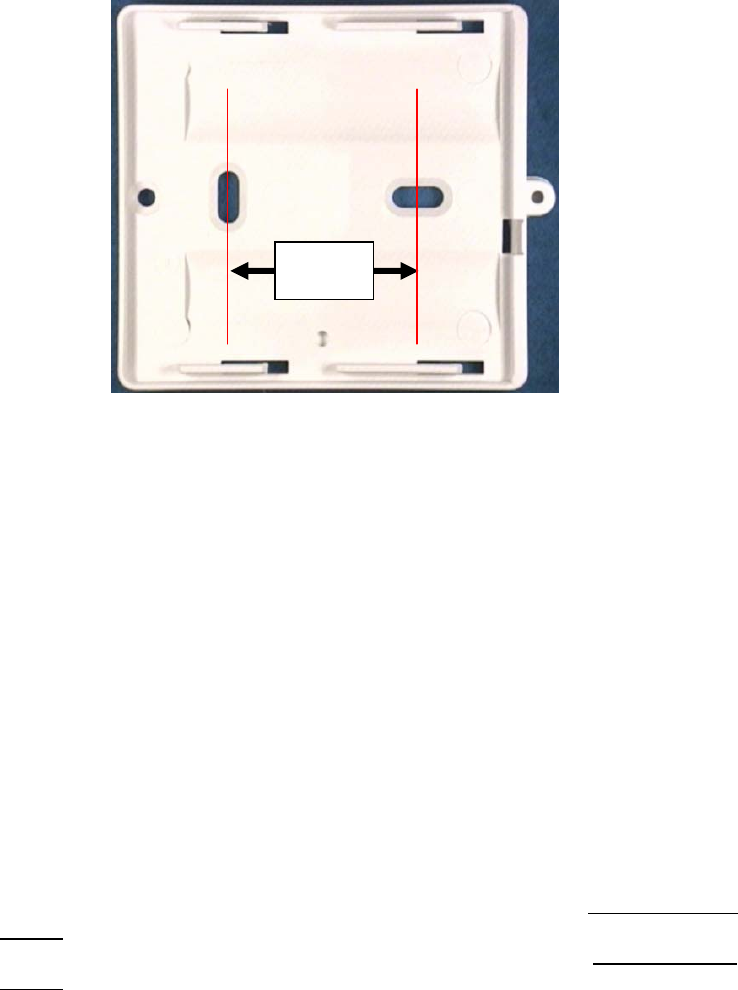
EkoTek System Installation and Configuration Manual
9261-8173 issue: 8 Page 25
© 2012 Multitone Electronics Plc
When mounting the mains powered devices it may be easiest to detach the
power cable from the circuit board first by gently pulling out the connector from
the board. The mains powered repeater/call point may be supplied with the
power cable already detached.
Use the back plate to mark the position of the screw holes on the wall or
ceiling. The call point may be mounted at desk height but if it is also to be used
as a repeater it should be mounted using the same criteria as a normal
repeater. The contact for the call point should then be extended to a switch
(such as a ceiling pull switch).
If fixing to masonry, drill two holes with 6mm masonry bit to a minimum depth of
30mm and insert wall plugs.
Screw the back plate in position making sure the screws are left flush to back
plate.
When installing a mains powered repeater, refer to ‘Wiring the mains powered
repeater/call point’.
If installing a call point that needs to be wired to an external switch, refer to
‘Wiring the call point to an external switch’.
After installation, lock the devices (if required) by screwing the small screw
provided in the installation parts, as indicated by A in the picture on previous
page.
Wiring the mains powered repeater/call point
Note:
1. The mains powered repeater requires a DC supply between 9.5v and 15v at
15mA.
2. The mains powered call point requires a DC supply between 11v and 15v at
25mA.
3. When wiring several repeaters in a chain it is important to specify the system
power supply and cabling so that the power supply voltage at the repeaters
at the beginning and end of the chain are within these limits, taking into
account cable resistance. It is advisable to check these voltages with a
meter after installation has been completed.
44m
m
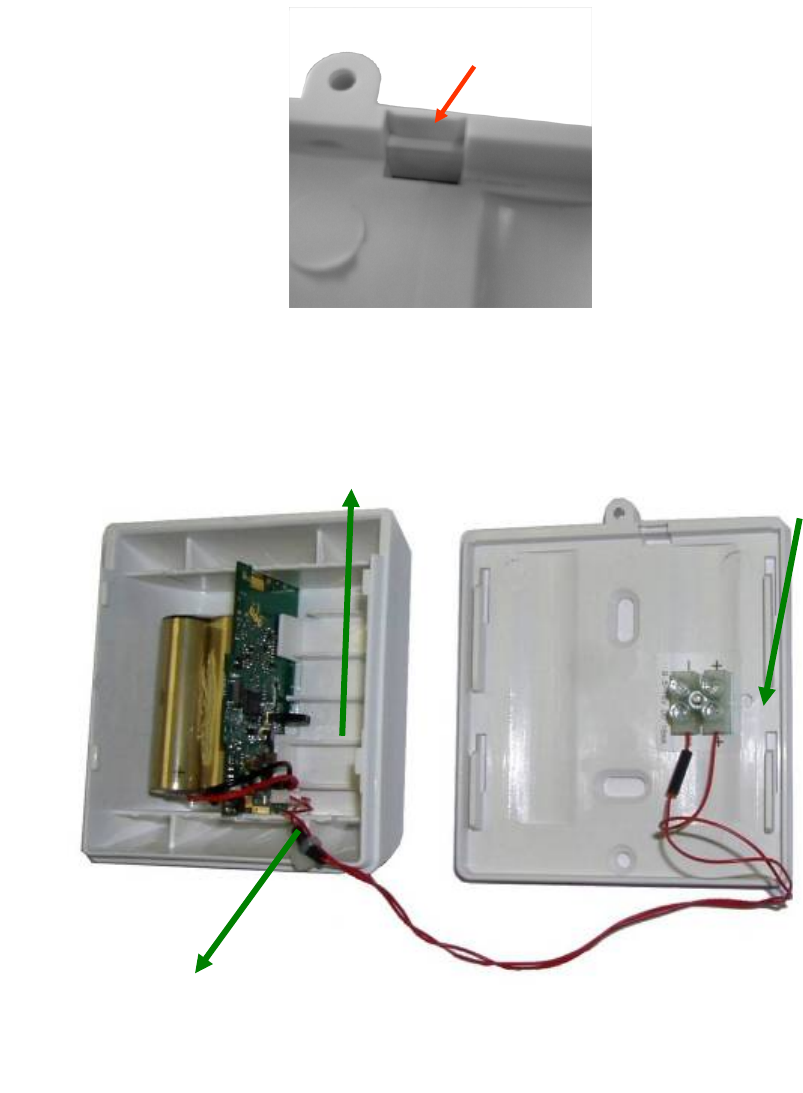
EkoTek System Installation and Configuration Manual
9261-8173 issue: 8 Page 26
© 2012 Multitone Electronics Plc
Create an exit point for the wires from the mains powered repeater by removing
the section indicated in the illustration below with a pair of pliers.
Break away case here to
create exit point for wires.
Turn on the mains powered device by removing the link from the repeater PCB.
Wire the supply leads to the device using the screw terminals in the connecting
block. Note: Be careful to observe the correct polarity as shown on the label.
Before sliding the mains powered device back on to the base plate, offer the
device up to the base plate and plug the power connector into the circuit board.
Ensure the batteries are in place then slide the device on to the base plate.
Take care not to snag the power cable.
Wiring the call point to an external switch
The call point may be wired to an external switch if alarms are to be initiated
from a location that is remote from the call point.
Remove this connector if desired while
fitting the base plate. Remember to
reconnect it to complete the installation.
Connection block.
Observe polarity. Remove this link and turn through
90 degs to be able to use to disable
battery in future
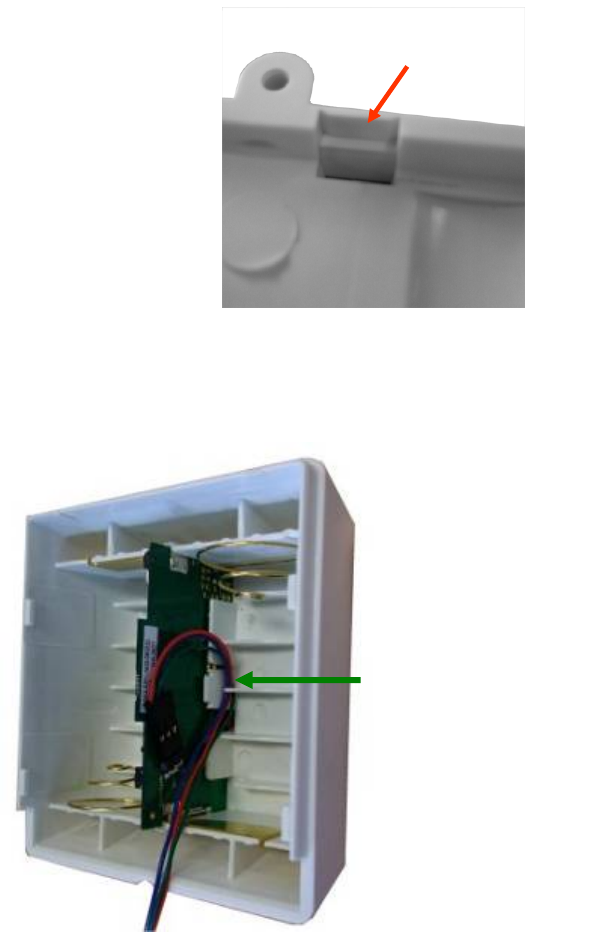
EkoTek System Installation and Configuration Manual
9261-8173 issue: 8 Page 27
© 2012 Multitone Electronics Plc
Create an exit point for the wires from the call point to the external switch by
removing the section indicated in the illustration below with a pair of pliers.
Break away case here to
create exit point for wires.
A pre-wired header is provided with the call point and this should be attached
paying particular attention to forming the wires as shown below to avoid
snagging them when sliding the unit on to the back plate.
The header is wired as follows:
Pin 1 = External alarm activate.
Pin 2 = Ground (for both contacts).
Pin 3 = External alarm cancel. Connecting this input to the ground pin has the
same effect as a long press on the front button of the call point, clearing
any alarm that the call point has raised.
Place wires as shown
here.
EkoTek System Installation and Configuration Manual
9261-8173 issue: 8 Page 28
© 2012 Multitone Electronics Plc
4. Installing the solar repeater
Solar repeater positioning
The repeater should generally be sited with the solar panel facing the sun at its
zenith. It must have at average of at least 30 minutes a day of sunlight shining
on the solar panel even in the winter months (note: that snow and ice covering
the repeater for long periods may cause problems). The normal annual
maximum and minimum temperatures must be within the range -20ºC to
+35ºC, although brief periods outside this range will probably not result in
failure.
Solar insolation (solar radiation received at the earth's surface) maps can be
used to help determine an area’s suitability. Near the equator, temperature
may be more important than hours of sunshine and facing the solar repeater
east so that the unit is not in direct sunlight in the hottest part of the day may be
best.
The repeater should be sited so that there are no obstructions causing the solar
panel to be shielded from the sun at any time during the year. For example, in
London, England (latitude 51.5ºN) the sun only reaches 15º above the horizon
on the shortest day of the year, so the ideal location will be facing south with no
obstruction more than 15º above the horizon.
Use of a compass is recommended.
The solar repeater comes with the batteries pre-installed and must be mounted
in a vertical position since the unit has been designed to be switched off when
lying on its side.
The solar repeater is distributed with two fixing kits, one designed for wall
mounting and one designed for pole mounting.
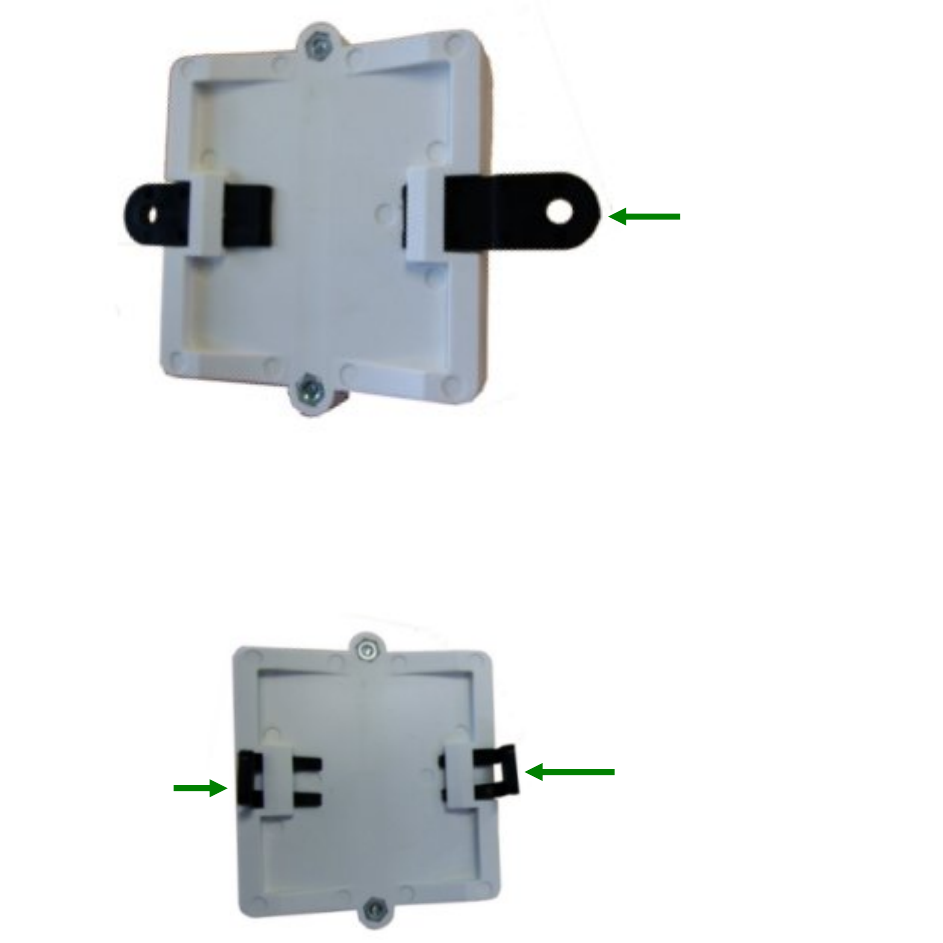
EkoTek System Installation and Configuration Manual
9261-8173 issue: 8 Page 29
© 2012 Multitone Electronics Plc
Wall mounting
The solar panel is fixed to a wall using screw fixing brackets that are attached
to the repeater as shown below:
Pole mounting
The solar panel is fixed to the pole using a nylon strap (not provided with the
repeater) that passes around the pole and through fixing brackets that are
attached to the repeater as shown below:
Insert strap fixing
brackets into the
slots on the back of
the solar panel.
Nylon strap passes
through the bracket.
Insert screw fixing brackets into
the slots on the back of the solar
panel.
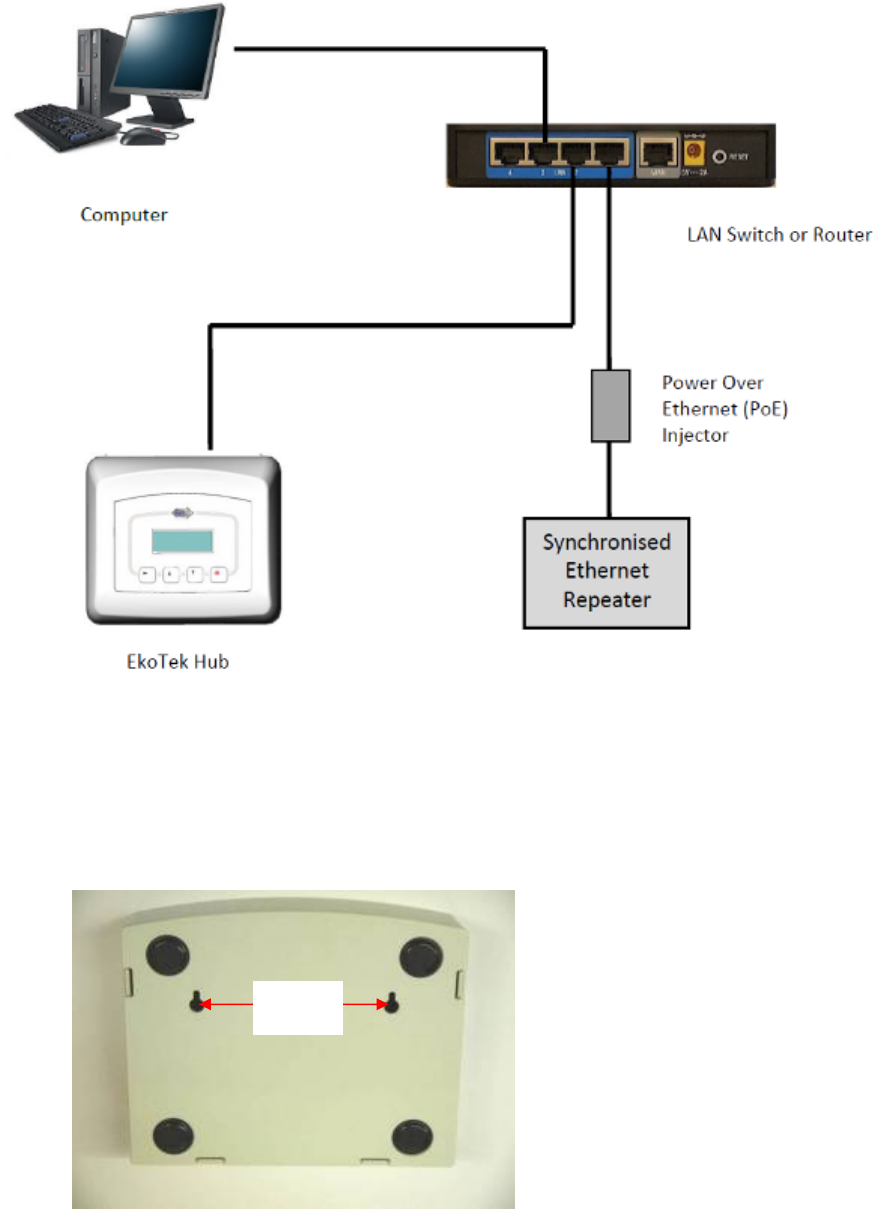
EkoTek System Installation and Configuration Manual
9261-8173 issue: 8 Page 30
© 2012 Multitone Electronics Plc
5. Installing Synchronised Ethernet Repeater (SER)
The SER can be installed either by wall-mounting (recommended) or placed on a
non-metallic surface. It must be within the vicinity of AC mains supply and Ethernet
connection.
If wall mounting then turn the unit over and measure the distance between the
mounting holes and using the tools previously mentioned drill two holes for mounting.
Note: The SER product design may change in future releases.
Read EkoTek SER user guide before configuring SERs.
90mm
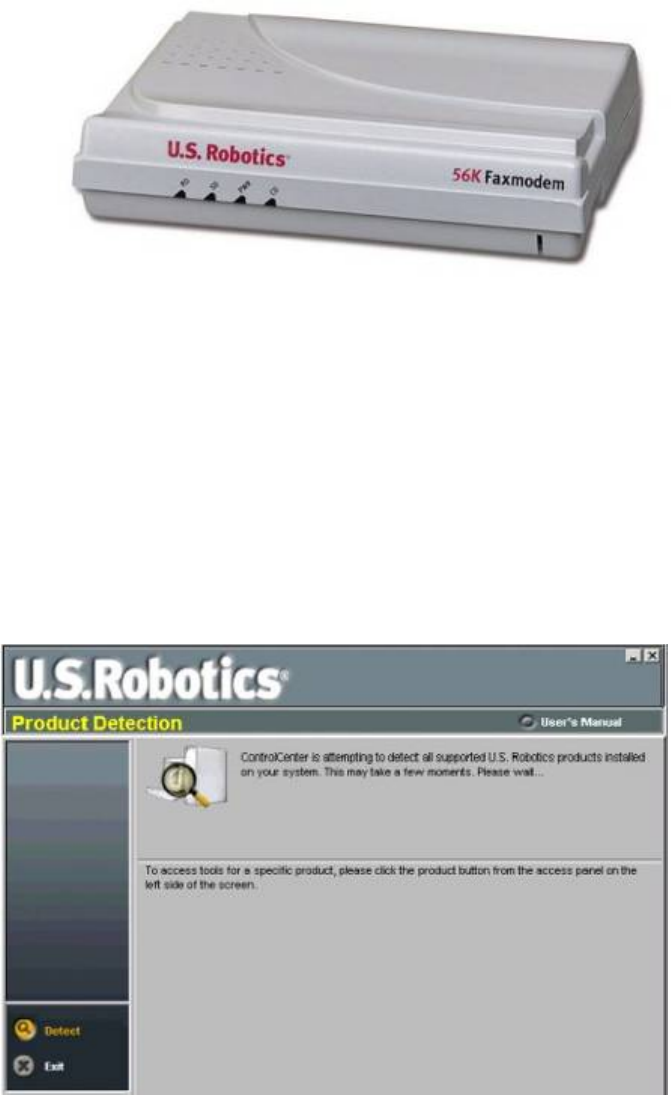
EkoTek System Installation and Configuration Manual
9261-8173 issue: 8 Page 31
© 2012 Multitone Electronics Plc
6. Installing the PPP modem
Connecting the modem
The PPP connection (port B) to the hub is made using a US robotics 5630D
modem.
1. Plug the modem into the serial port of a PC using the serial interface cable
provided with the modem. Use an adapter if the PC does not have a serial
port. (See Appendix 3: RS232 cable pin-outs for connecting the modem to
the hub (page 81) for details of cable pin-outs).
2. Install the US Robotics software onto the PC, from the CD provided with the
modem.
3. After installation, locate the software in the programs menu on the PC and
start.
The software automatically detects if the modem is connected.
Click the configuration manager and go to the call control tab.
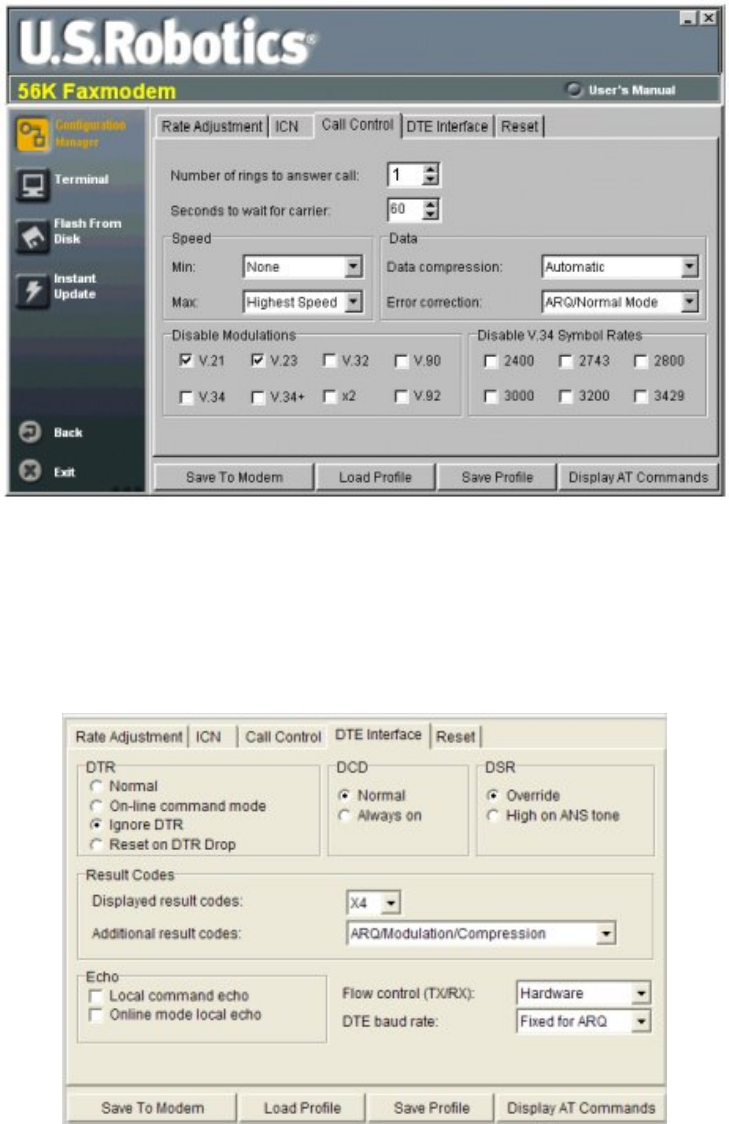
EkoTek System Installation and Configuration Manual
9261-8173 issue: 8 Page 32
© 2012 Multitone Electronics Plc
Set the ‘Number of rings to answer call’ box to 1.
Click the ‘Save to modem’ button, which stores the current values from the
configuration manager's fields to the writable memory of the modem.
Go to the DTE interface tab and set the DTR to ignore DTR.
Using Windows Hyper Terminal to set the interface speed
A terminal program is an application that will enable a PC to communicate
directly with a modem. If you are using Windows 2000 or Windows XP, you
can use the Windows HyperTerminal program as it is included as part of the
operating system.
1. Check that the modem is connected to a serial port on the PC.
2. Load HyperTerminal:
Click Start > Run
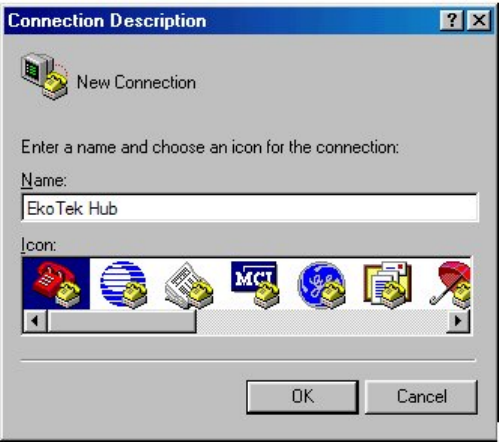
EkoTek System Installation and Configuration Manual
9261-8173 issue: 8 Page 33
© 2012 Multitone Electronics Plc
In the box which appears, type HYPERTRM
Click OK
If you see the error message 'Cannot find HYPERTRM' you will need to
install HyperTerminal:
Click Start > Settings > Control Panel > Add / Remove Programs.
In Add / Remove Programs select Properties and then click the
Windows Setup tab
Double-click Communications
Check the box for HyperTerminal
Click OK, and then OK again to install
Note: You may be asked for your Windows installation disk for this
procedure
3. When Hyper Terminal starts you will be presented with a 'Connection
description' dialogue box.
Click 'Cancel' to continue
4. Select the preferred COM port:
Select 'File' then 'Properties' from the menu bar and the 'New
connection properties' window will open
Click on the arrow for the 'Connect using' drop down box
Select 'Direct to ComX' (where X is the COM port you are using to
connect the modem - e.g. COM1, or COM5, etc)
Click OK
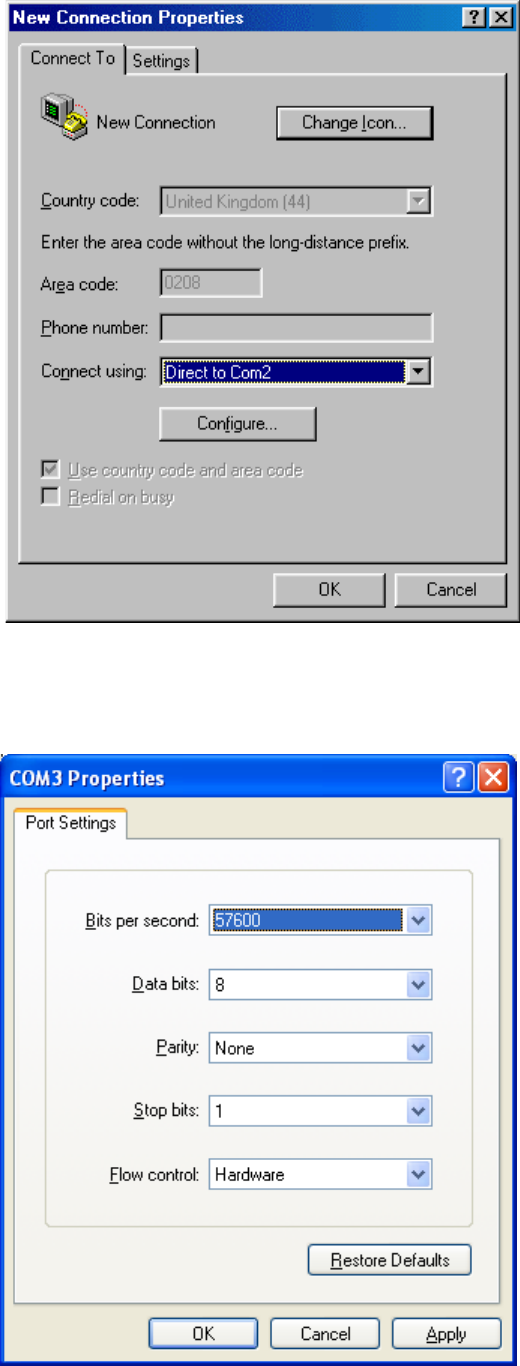
EkoTek System Installation and Configuration Manual
9261-8173 issue: 8 Page 34
© 2012 Multitone Electronics Plc
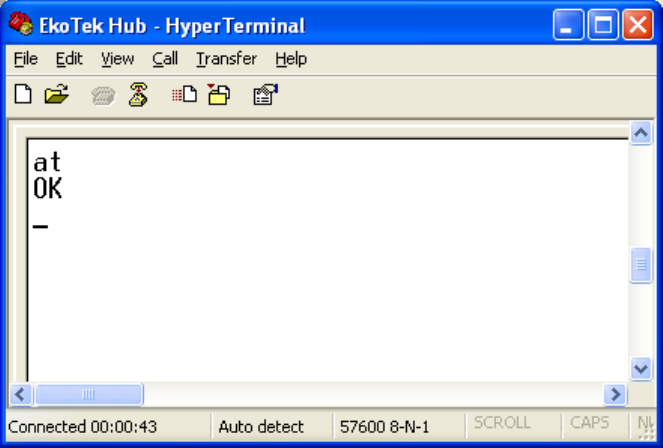
EkoTek System Installation and Configuration Manual
9261-8173 issue: 8 Page 35
© 2012 Multitone Electronics Plc
Configure the port to set the interface speed to 57600
5. Click OK - a blank terminal window will open. You should now be
communicating directly between the COM port and modem.
Type 'AT' [enter]
If you are communicating, the modem will reply with 'OK'. If so, proceed to
step 6.
If no 'AT' or 'OK' appears, then there is a basic communication issue
between the PC and the modem - most likely the COM port selected is
incorrect - check this and try again.
If problems persist:
Check Windows Device Manager (where available)
Check that the modem is installed
Check the COM port is enabled and has no clashes (indicated by a
yellow exclamation mark next to it)
Check the COM port is enabled in the system BIOS setup
6. To store the configuration of the port speed in the modem, type 'AT&B2&W'
[enter]. You should receive 'OK' as a response.
7. Remove the lead from the PC COM port and connect to Port B on the hub.
8. Close the cover on the hub. Ensure that the ribbon for the keypad is
connected to the header on the daughter board, as this is sometimes
dislodged when the cover is removed.
9. Test by dialling in to the modem from a PC. The user name and passwords
are both ‘EkoTek’. The modem should auto answer and the EkoTek menu
screen should be displayed.
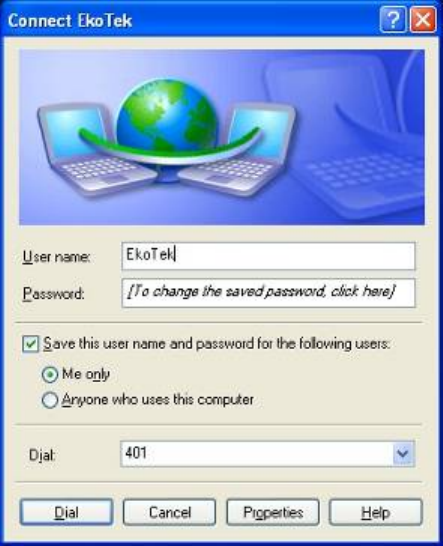
EkoTek System Installation and Configuration Manual
9261-8173 issue: 8 Page 36
© 2012 Multitone Electronics Plc
Set up system configuration using the browser as described in the ‘
8. Browser interface section’.
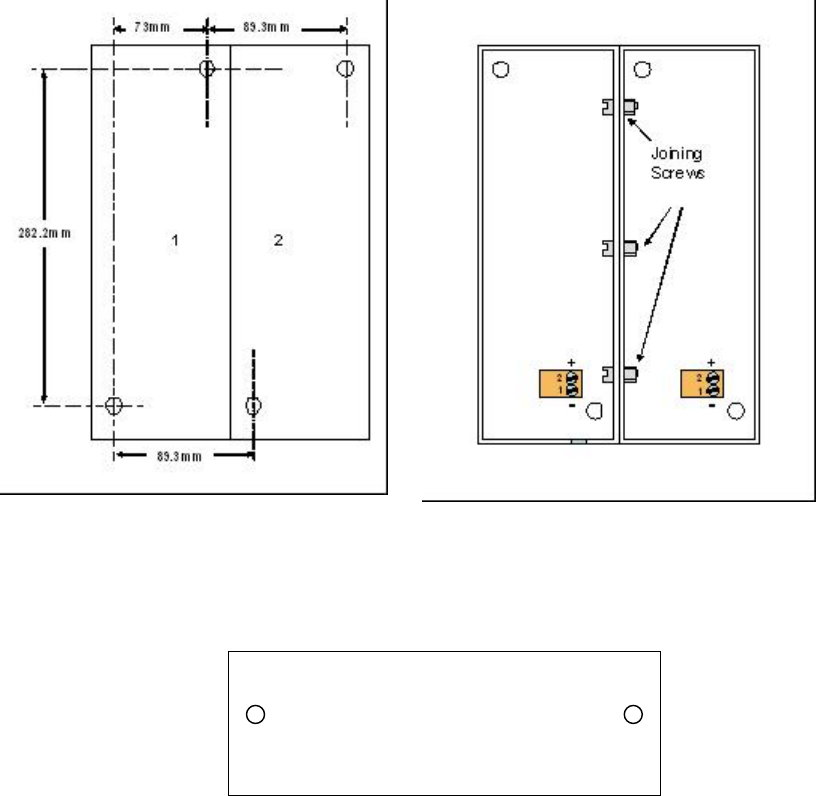
EkoTek System Installation and Configuration Manual
9261-8173 issue: 8 Page 37
© 2012 Multitone Electronics Plc
7. Installing the four-way pager charging rack
Up to 2 four-way charging racks may be supplied from the PSU.
Wall mounting
Measure and drill the wall according to the diagram: on next page
If two units are used, join together using the nylon screws and nuts provided as
shown below:
Warning label
Fix the warning label close to the rack where it is easily visible.
RECHARGEABLE
CELLS ONLY
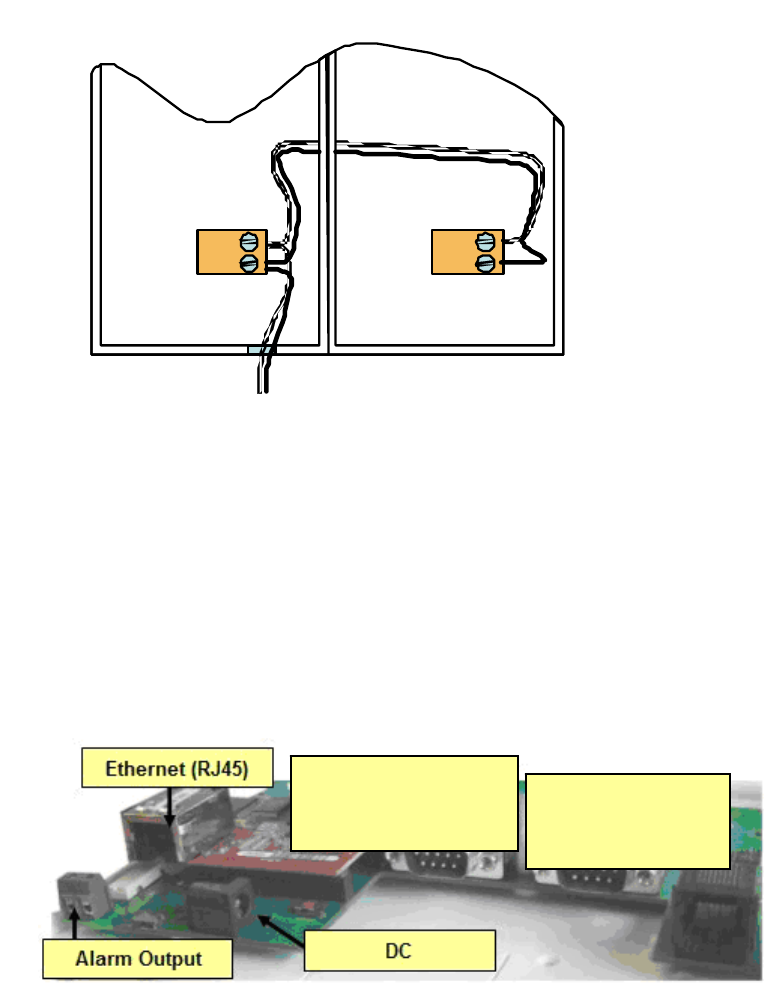
EkoTek System Installation and Configuration Manual
9261-8173 issue: 8 Page 38
© 2012 Multitone Electronics Plc
IDC connections
Remove or cut off the power jack from the end of the PSU lead. Bare the ends
and connect to the IDC connector in the first rack. Ensure the polarity is
correct, (+ve black with the white stripe) as shown in the diagram above. Loop
the supply through to the second rack if fitted, and terminate as shown in the
diagram below.
++
--
2
12
1
+ve Black/White -ve Black
8. Browser interface setup
Initial setup
In order to configure the system a PC or a network Ethernet connection needs
to be made to the hub. This connection can also be used to monitor the
EkoTek network. Once the connection has been made, then communication
with the hub is achieved through a web browser.
Connecting the hub to the PC using Windows XP
On the PC:
1. Click the Windows start menu and select Control Panel.
2. Click ‘Network and Internet connections’.
3. Click ‘Network Connections’. With the network cable disconnected, the
Local Area connection will be shown as unplugged (X).
Port A -
(DB9) Port B -
(DB9)
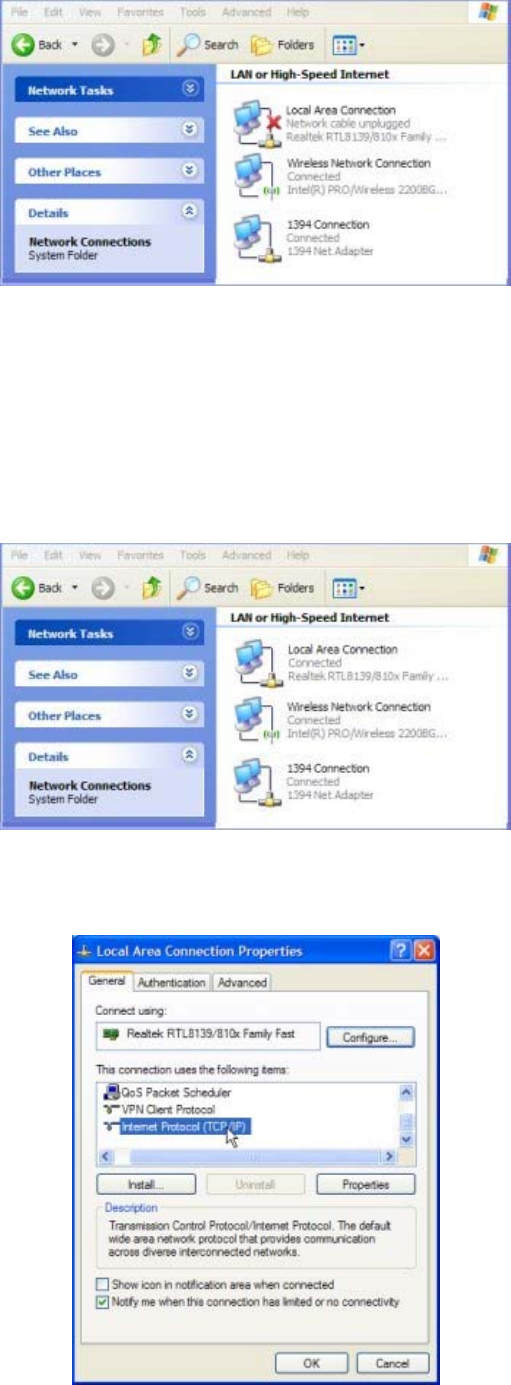
EkoTek System Installation and Configuration Manual
9261-8173 issue: 8 Page 39
© 2012 Multitone Electronics Plc
4. Open the hub. To open the hub, push the two locking tabs in and then
separate the cover from the back plate.
5. Connect an Ethernet (RJ45) patch cable to the RJ45 connector - see the
hub interfaces diagram.
6. Connect the other end of the patch cable to the Ethernet (RJ45) connector
on the PC. Note: Some network cards require a crossover cable for direct
connection.
7. If connected correctly the screen will change to show the cable connected.
8. Double click the ‘Local Area Connection’ icon to open the properties
window.
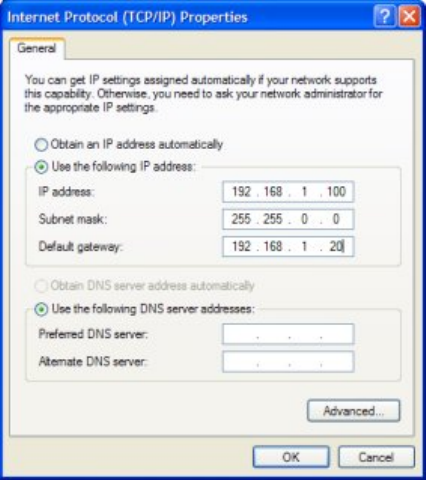
EkoTek System Installation and Configuration Manual
9261-8173 issue: 8 Page 40
© 2012 Multitone Electronics Plc
9. Scroll the new window and select the ‘Internet Protocol TCP/IP’ menu item.
10. Click the ‘Properties’ button.
11. The default shipped configuration for the hub is:
IP address: 192.168.1.2 (1.1.1.1 if via PPP serial port)
Subnet mask: 255.255.0.0
Default gateway: 192.168.1.20
In order to communicate between the PC and the hub, the IP address of
the PC has to be set to the same network and subnet as the hub. To
achieve this select ‘Use the following IP addresses and enter the IP
address in the same range as the hub (in the example above
192.168.1.100 and a subnet mask of 255.255.0.0 Gateway 192.168.1.20).
12. Click ‘OK’ to finish.
Using the web browser to access the hub
In the address field of the web browser, type the IP address of the hub (default
is 192.168.1.2 for Ethernet) and click the refresh button. The browser then
connects to the hub web interface.
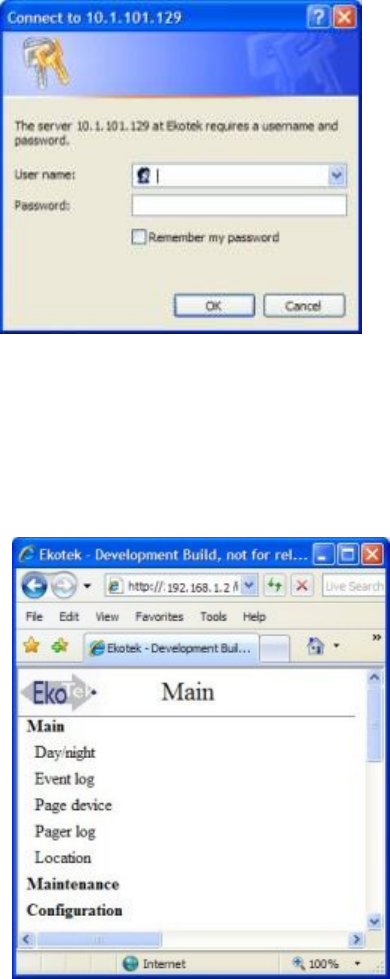
EkoTek System Installation and Configuration Manual
9261-8173 issue: 8 Page 41
© 2012 Multitone Electronics Plc
Password
When a configuration menu item is opened at the beginning of a session, a
password is requested. The default is user name ‘admin’ with no password
(blank). Once access is gained the password can be set as required. In
addition, user name ‘user’ (blank password) gives access to ‘Main’ and
‘Maintenance’ menu items, and ‘Passwords’ and ‘Browser language selection’
under the ‘Configuration’ menu.
9. Main menus
Note: The mains powered devices appear to the system to be identical to a regular
repeater or call point. Wherever a reference to a repeater or call point is seen this
also applies equally to the mains powered variants.
admin
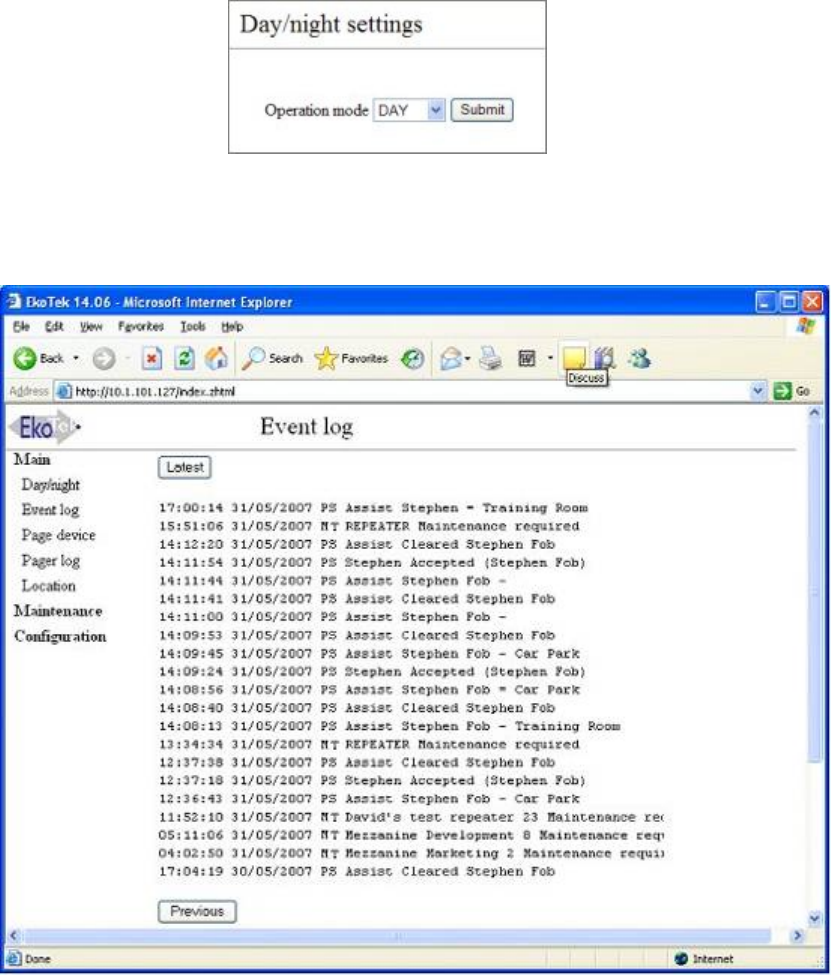
EkoTek System Installation and Configuration Manual
9261-8173 issue: 8 Page 42
© 2012 Multitone Electronics Plc
Day/night
Use to set the shift mode. This can be used in conjunction with alert rules to
route alarms to different target groups.
Event log
The event log keeps track of all events on the system. It records:
The time and date for each event recorded
The type of event and the text of the associated message
For each of the applications the following events are recorded:
PS = personal security: Alarms raised, accepted and cleared
PG = paging application: Pager messages sent, delivery report if
requested, any user responses if requested
MT = maintenance: devices not reporting status or low battery
warnings – these messages are also sent to pager group one (1)
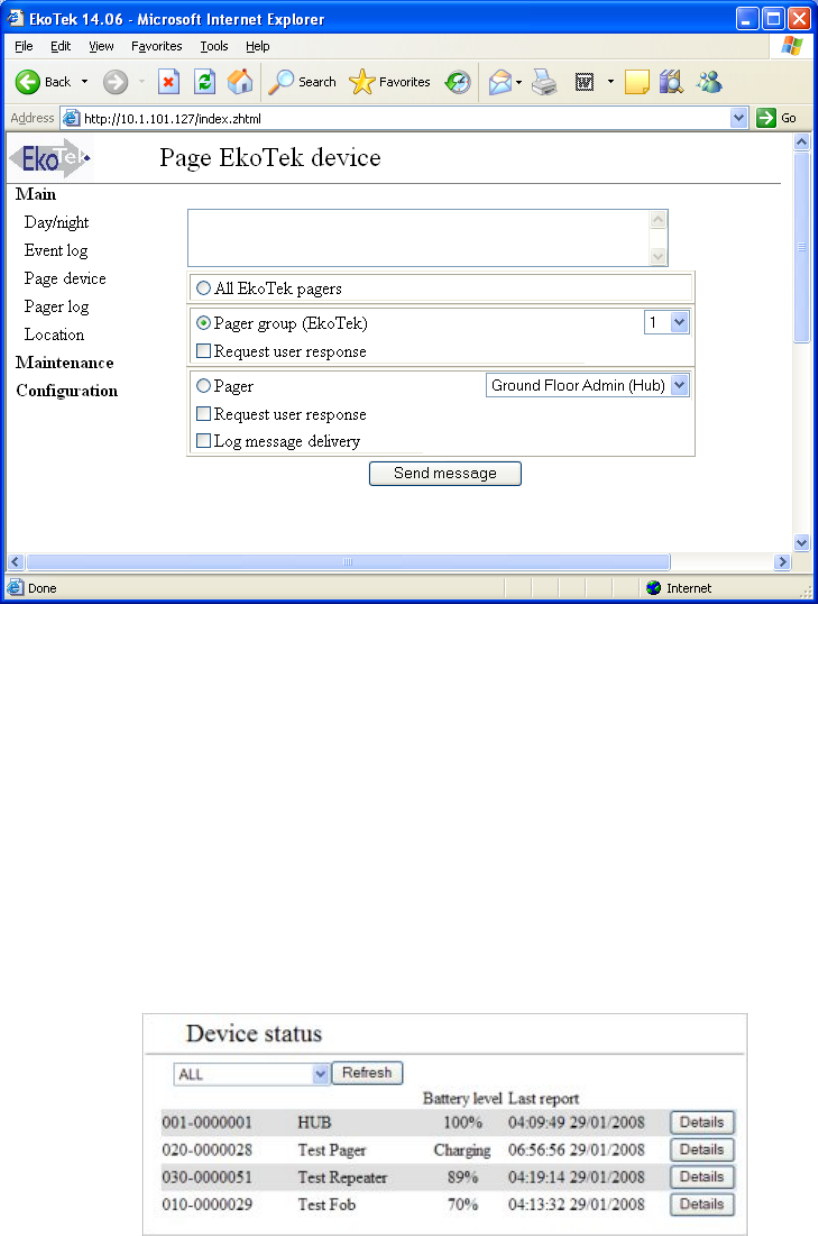
EkoTek System Installation and Configuration Manual
9261-8173 issue: 8 Page 43
© 2012 Multitone Electronics Plc
The event log stores the last 9000 events in flash memory. Once 9000 events
have been recorded, any new event received is stored and the earliest
recorded event is removed from the log.
Page device
Paging messages can be sent from this screen to all EkoTek pagers, pager
groups (select group from drop list) or individual pagers (select pager from drop
list). Two-way pager messages for user responses may be requested for pager
groups or individual pagers, and delivery of messages to individual pagers may
be logged.
Pager log
The pager log stores the last 15 pager messages that had either ‘Log message
delivery’ or ‘Request user response’ ticked. Messages are kept until the 16th
new message with response or delivery request ticked, or if hub is reset.
Note: The pager messages are also written into the event log.
Location
If location reporting for mobile devices has been enabled under the device
mode, the location screen shows the last location reported by each mobile
device.
If a device does not have location reporting enabled ‘Not enabled’ will appear in
place of the location report time and location.
If a device has not reported its location since the hub has powered up it will
display ‘Unknown’.
10. Maintenance menus
Device status
"Enter message here”
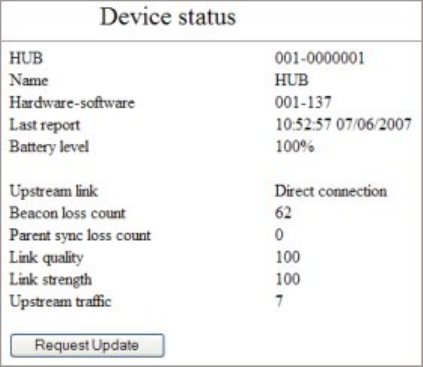
EkoTek System Installation and Configuration Manual
9261-8173 issue: 8 Page 44
© 2012 Multitone Electronics Plc
Each device in the mesh connects to the hub via a parent device (repeater or
directly to the hub itself). Maintaining this connection is important. These
statistics relate to that connection. Status reports are made every 4 hr 33 min 4
sec.
Device statuses in the list are highlighted as follows:
Low battery = yellow
Replace battery = red
Missed status report = yellow
Missed four consecutive status reports = red
Device status - hub and IP slave hub
Hub: Serial number.
Name: Name given to the hub.
Hardware - software: revision number.
Last report: Time and date stamp of last report.
Battery level: For the hub this will always be 100% when running on mains
power. Battery level (%) will be indicated when on backup power.
Upstream link: This will always be ‘Direct connection’. It is the topmost link of
the network.
Beacon loss count: This count records beacons lost since startup or reset.
Parent sync loss: Number of times that a loss of sync has occurred since
startup or reset.
Link quality: general quality of link to the hub, 1 to 100 where 100=best. Direct
connection is always 100.
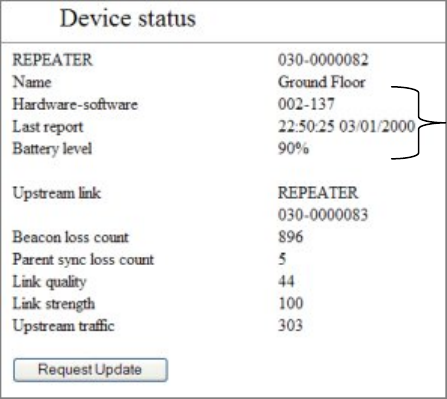
EkoTek System Installation and Configuration Manual
9261-8173 issue: 8 Page 45
© 2012 Multitone Electronics Plc
Link strength: RSSI of parent link, 1 to 100 where 100=best. Direct connection
is always 100.
Upstream traffic: Count of packets sent to parent.
The loss counts and upstream traffic are simple incrementing counters.
Device status - repeater, solar repeater and call point
Repeater, solar repeater or call point: Serial number.
Battery level: Shows the battery level. An alarm is given when battery level
drops to 20% and a replace battery message initiated at 5%.
Upstream link: Name and serial number of parent repeater or hub.
Beacon loss count: Missed parent beacons. This counts the number of times
the beacon was expected but not received, either through a faulty parent or
degradation of the signal to the parent.
Parent sync loss: Number of times that a loss of sync with parent has occurred.
Other fields are the same as for the hub.
If no status report
has been received
these will show
***-***
Awaiting status
report
Unknown
All other fields will
be blank.
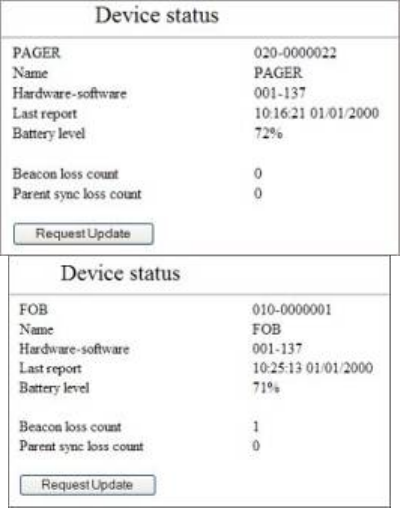
EkoTek System Installation and Configuration Manual
9261-8173 issue: 8 Page 46
© 2012 Multitone Electronics Plc
Device status - call fob and pager
Pager or fob: Serial number.
Name: Name given to device.
Hardware - software: revision number.
Last report: Time and date stamp of last report.
Battery level: Shows the battery level (%) or ‘Charging’ if the battery is being
charged.
Beacon loss count: Missed parent beacons. This counts the number of times
the call fob or pager has lost contact with its parent either, through faulty parent
or degradation of the signal through moving out of range of the repeaters.
Parent sync loss: number of times that a loss of sync with parent has occurred.
Request update: Click to retrieve current statistics.
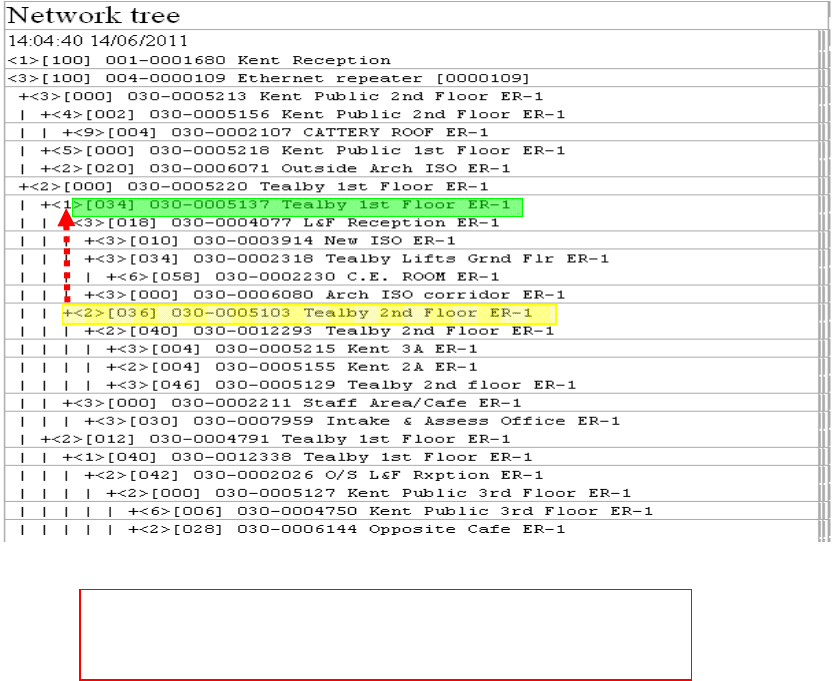
EkoTek System Installation and Configuration Manual
9261-8173 issue: 8 Page 47
© 2012 Multitone Electronics Plc
Tree View
The network tree is used to try to provide information relevant to the fixed
devices in the system. Information provided includes:
Number of times a device requests it’s Config from hub
o A high number may indicate the need for additional repeaters – to overcome
poor radio connections
The RRSI level (as indicated above)
o A high number shows a good link but a low number does not necessarily mean
a poor link (it is for the last status report only and conditions /parent selections
change)
The linkage paths between devices
o This chain length to a given repeater is the number of ‘I’ symbols in front of it
Identifies parent and child relationship
The parent can be identified from the child by identifying the (+) and tracking
upwards to the (<n>). The number of (I) indicates the number of hops from the
hub. This can lead to an unstable network with poor connections.
11. Configuration menus
System settings - hub
This page sets the network interfaces. It enables configuration of hub settings,
clock, external connections and the browser language.
Click ‘Configuration’ and select ‘System’.
Parent
–
030-0005137
Child
–
030-0005103
<n> = Number of requests for Config [n] =
RSSI Level
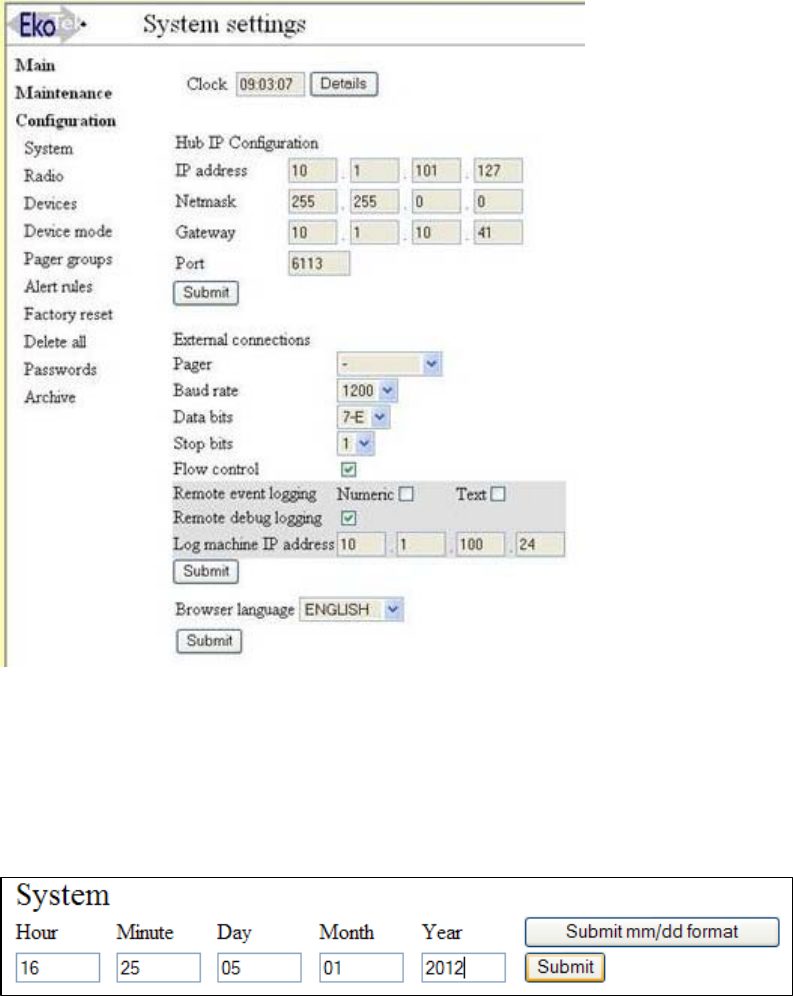
EkoTek System Installation and Configuration Manual
9261-8173 issue: 8 Page 48
© 2012 Multitone Electronics Plc
Set clock
The clock operates in two modes, one displaying the current time (if JavaScript
is enabled on the browser this will update, if not then the clock is a snapshot of
the time the page was loaded).
1. Click the details button and enter the current time and date.
2. Click ‘Submit’ to set.
Note: An illegal clock setting will return to clock display mode, but the
original settings will be retained.
Set date format
The hub allows either of two date formats to be selected:
Day/Month/Year – displayed as ’05.01.12’
Month/Day/Year – displayed as ’01.05.12’

EkoTek System Installation and Configuration Manual
9261-8173 issue: 8 Page 49
© 2012 Multitone Electronics Plc
The date format applies to the hub/pager displays and the hub web server
pages showing logs, location and maintenance information.
To change the date format click the submit button. This will change the date
format to that shown on the button. The button then changes to show the other
format. For example, a screen similar to the above will be seen if the date is
set to Day/Month/Year format and clicking the ‘Submit mm/dd format’ button
will change the display to Month/Day/Year.
Hub IP configuration
If the hub is to be connected to an Ethernet network the IP address, subnet
mask and gateway should be set within the address range of the network, to
allow the hub to be accessed from the network. In general the port should be
left at the default value, (6113), unless this port is being used for another
application on the network. Once the IP address is configured the hub can only
be accessed using that IP address, so a note should be made of any IP
address that is set. If the address of a hub is unknown it can be obtained from
the front panel. See the EkoTek hub user guide 9261-8276 for details.
Note: An illegal IP setting will return to the system settings screen and the
original settings will be retained.
Remote system connection
For setting up the connection to an external system, such as a paging or nurse
call system. Refer to Appendix 6 ‘External system connections’ (page 85) for
details of remote system configuration.
Remote logging
1. Click ‘Remote event logging’ to allow system event messages be sent to a
remote logging machine.
2. Select ‘Numeric’, ‘Text’ or both depending on the required output.
3. Click ‘Remote debug logging’ to forward all received/transmitted messages
to remote machine.
4. Set the IP address of remote logging machine of the remote computer.
Click ‘Submit’ to set the new external connection settings. Logging
messages are always sent to UDP port 514.
Note: No check is made that the remote logging machine exists.
For more details of the event logging protocol see Appendix 4B: Channel
allocation with SER
1. Overview
The SERs is used in a customer network to provide
synchronised radio coverage over a larger site without having
to resort to separate or overlapping systems. The repeater
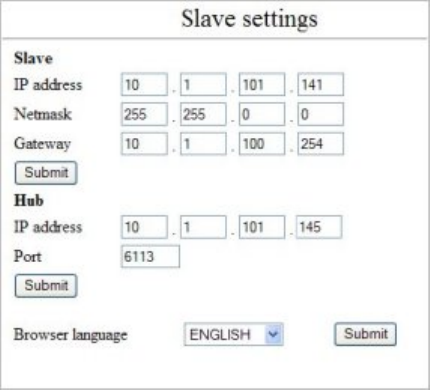
EkoTek System Installation and Configuration Manual
9261-8173 issue: 8 Page 50
© 2012 Multitone Electronics Plc
operates in a similar way to a normal repeater except for the
fact it is linked back to the hub via the customer’s LAN. Each
SER is allocated its own channels to operate in its own area
and link with the other repeaters in its vicinity, because it is
linked back via the LAN it does not need to be able to reach
back to the hub via the radio path.
This helps to reduce long chains of repeaters across a larger site and means set
channels can be used in different areas of a large site. This helps to ensure a stable
radio network. Linking between buildings can be done using SERs via LAN where
before a ‘chain of repeaters’ would have been required (this helps by reducing the
overall device count on the system).
With complex network setups advice should always be sought from Multitone
Customer Services for assistance when planning this type of installation.
Appendix 5: Remote logging protocol (page 85).
Language
The browser interface is available in multiple language variants and it is
therefore important to ensure you have the correct version installed for your
customer. Select the required language from the drop list and click ‘Submit’.
System settings – IP slave hub
This page sets the network interfaces for the slave hub and the browser
language.
Click ‘Configuration’ and select ‘System’.
Slave
The IP address, subnet mask and gateway should be set within the address
range of the network, to allow the hub to be accessed from the network. Once
the IP address is configured, then the slave hub can only be accessed using
that IP address, so a note should be made of any IP address that is set. If the
address of a hub is unknown it can be obtained from the front panel.
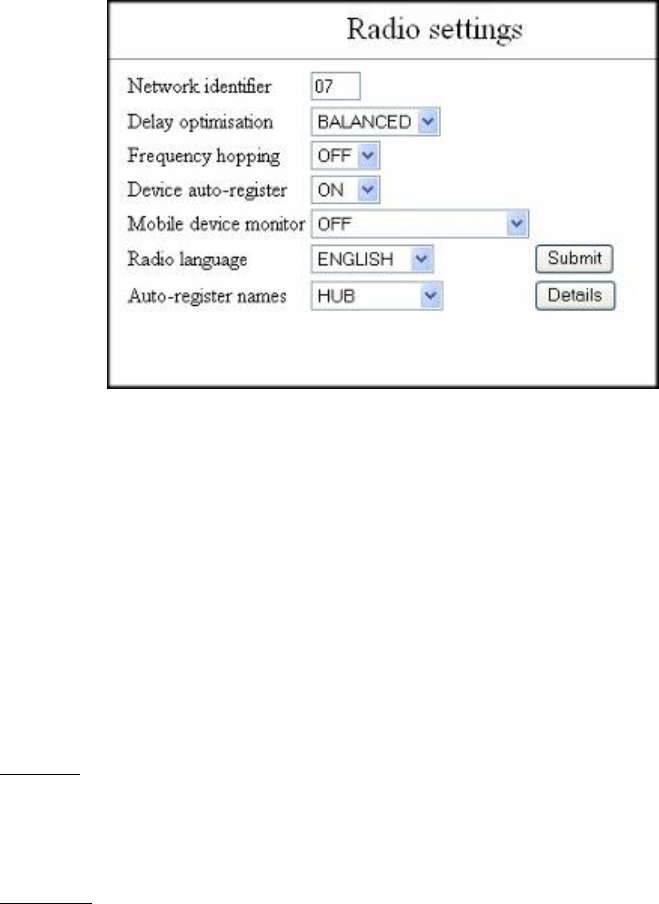
EkoTek System Installation and Configuration Manual
9261-8173 issue: 8 Page 51
© 2012 Multitone Electronics Plc
Click ‘Submit’ to save the slave hub settings.
Hub
IP address: Enter the IP address of the main system hub.
Port: Set the port to that set in the system settings for the main hub.
Click ‘Submit’ to save the main hub settings.
Radio settings
Network identifier
The network identifier enables mobile devices to differentiate between EkoTek
systems. Depending on its configuration the mobile device may ignore a
different system (if configured to lock to a single network identifier) or attempt to
log on to any system. The mobile device will get its configuration from the
system it is logged on to. For a mobile device to successfully move between
systems it must be able to detect the change, so each system it is to operate
on must have a different network identifier.
Note: Overlapping EkoTek networks are supported from release 3.0 onwards.
See Appendix 4A: Overlapping system support (page 82) for further details.
Delay optimisation
‘Inbound’ is used for maximum speed of delivery in the direction towards the
hub and is normally only used when there are no pagers on the network, i.e. no
outbound user messaging. This is useful if external paging is intended as the
main method of alerting users.
‘Balanced’ is used where there are EkoTek pagers on the system, to give a
balanced speed of message flow across the radio network, both towards and
from the hub.
‘Balanced’ is fine for most applications and is the default.
Frequency hopping
The 2.4GHz band has 16 channels. Frequency hopping allows the radio to
change frequency (hop) between different channels in the band. This helps the
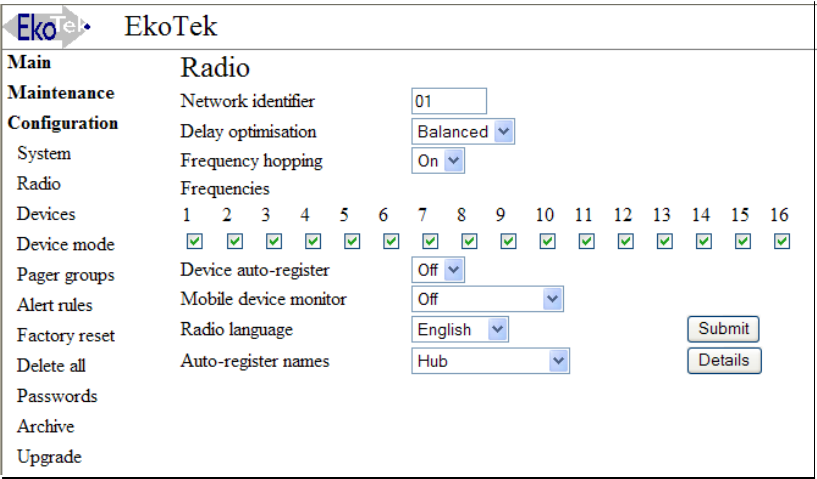
EkoTek System Installation and Configuration Manual
9261-8173 issue: 8 Page 52
© 2012 Multitone Electronics Plc
system avoid interference from Wi-Fi devices using the spectrum and offers
more security from eavesdropping, if this is a consideration.
The system can also be set to use a fixed frequency.
Usually only the first 14 channels are used for Wi-Fi systems and setting to use
a single fixed frequency in channels 15 or 16 could prove to be more robust
where there is heavy Wi-Fi usage. Set to ‘On’ (frequency hopping enabled) or
‘Off’ if not required. By default the hub is configured to the fixed frequency
option (’Off’).
By selecting ‘On’ and submitting, the following screen will be shown. This
allows you to select which channels to use to frequency hop with. This allows
that any local Wi-Fi operating channels can be de-selected and therefore
reducing the interference by using only clean channels to hop through.
Device auto-register
If device auto-register is set to ‘On’, any unknown device that is detected is
permitted to join the network provided that the device limits have not been
exceeded. These devices will be given default names. If the auto-register is
set to ‘Off’, devices need to be manually added to the database before they will
be recognised as on the system.
New devices are set to default to:
Default name
User group 1
Fixed device zone 1
Device mode 1
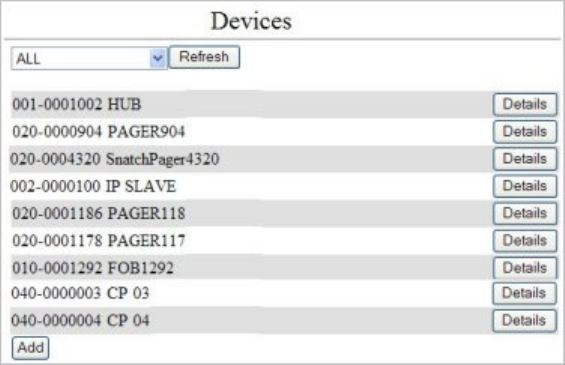
EkoTek System Installation and Configuration Manual
9261-8173 issue: 8 Page 53
© 2012 Multitone Electronics Plc
Any devices with a display will be added to the first pager group if capacity
exists.
Mobile device monitor
All fixed devices are automatically monitored for battery condition and presence
on the network, with maintenance messages generated on low battery or
absence of the device from the network; these messages are sent to all users
in pager group 1. Mobile devices (pagers and call fobs) can also be monitored
for battery condition and presence on the network. Set to ‘Off’, ‘Battery’ or
‘Network+Battery’ as required.
Note: The battery condition will be displayed on the ‘Device status’ page,
regardless of this setting.
Radio language
The pager display language is available in English, Francais, Espanol,
Deutsch, Svenska or Norsk. Select required language from the drop list and
click ‘Submit’.
Auto-register names
With the device auto-register set to ‘On’, when the network detects a device it
gives a default name appropriate to the device type: HUB, IP SLAVE,
REPEATER, SOLAR REPEATER, CALL POINT, PAGER or FOB. This default
name can be redefined if required.
Select device from the drop list and click ‘Details’. Enter a new name for the
default and click ‘Submit’ to set. For example, this sequence could be used to
set all pagers to register by default as ‘Staff’ and all call fobs as ‘Visitor’.
Devices
The devices page lists ALL the devices connected in the EkoTek network when
ALL is selected.
Refresh
To get the current list of devices, select the hardware type to be listed from the
drop list and click the ‘Refresh’ button.
The devices will then be listed;

EkoTek System Installation and Configuration Manual
9261-8173 issue: 8 Page 54
© 2012 Multitone Electronics Plc
1. The first column gives the hardware type and serial number of the device.
2. The second column gives the device name.
3. The third provides a ’Details ‘- button, to go to that specific device’s record.
The serial number of each device is displayed and the device name.
001-xxxxxxx indicates a hub.
002-xxxxxxx indicates a IP slave hub
004-xxxxxxx indicates an Ethernet Repeater
010-xxxxxxx indicates a call fob
020-xxxxxxx indicates a pager
030-xxxxxxx indicates a repeater
031-xxxxxxx indicates a solar repeater
040-xxxxxxx indicates a call point
Click the ‘Details’ button to see the device configuration.
Add
Click ‘Add’ at the bottom of the displayed list to go to the ‘Select device’ new
entry pages.
1. Select device type from menu.
2. Enter serial box and enter the serial number and name. The entry screen
below is for a repeater. Similar screens are shown for other device types,
with the appropriate hardware code displayed.
3. Click ‘Add’ to add the new device. If the entry is valid the individual device
entry page will then be displayed. If entry is not possible (invalid serial
number length, attempt to add a device prior to the hub, attempt to add a
second hub, too many devices already on-system, etc.) then ‘Invalid device
request’ will be displayed. If a device exists in the database with the same
serial number as the new requested device, the existing device details will
be displayed.
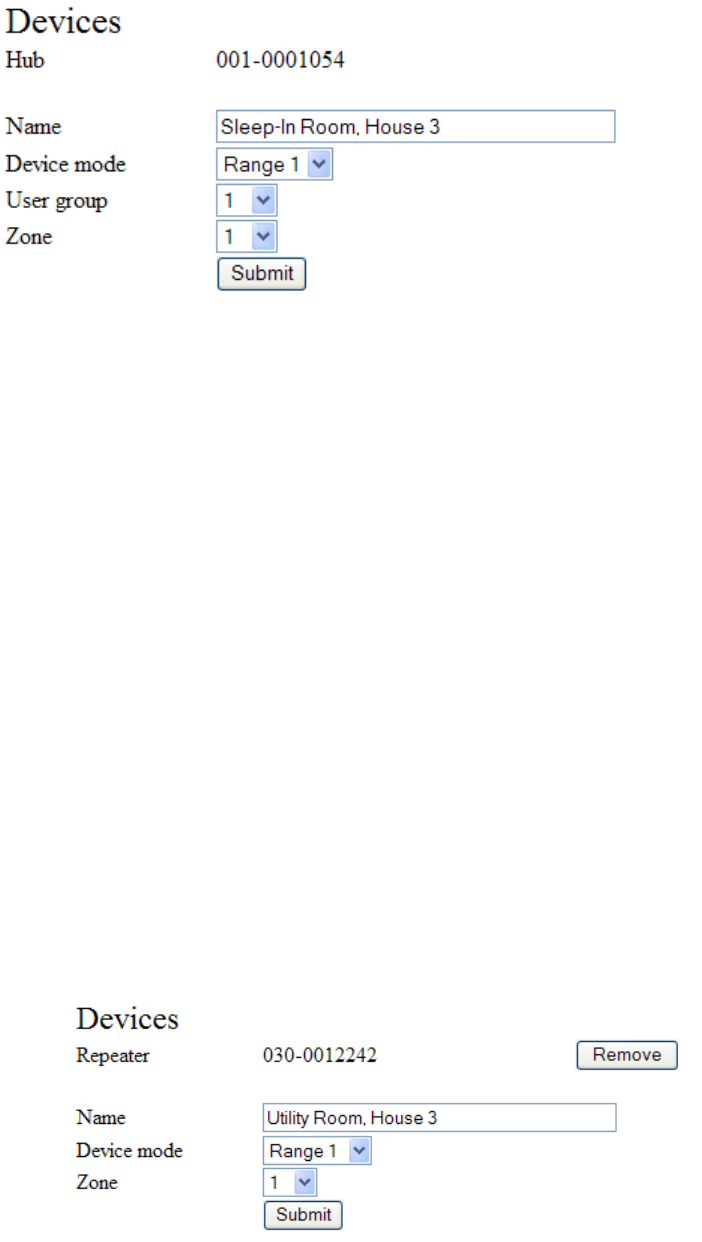
EkoTek System Installation and Configuration Manual
9261-8173 issue: 8 Page 55
© 2012 Multitone Electronics Plc
Details
Hub, IP slave hub and call point
Name
The name of the hub or call point may be changed, by entering a new name in
the box.
Device mode
The hub or call point is allocated a device mode (1-32), with 1 as default.
However, the name for each device mode can be user configured, in which
case different options will appear in this menu. The device mode defines the
behaviours of all similar devices (radio channel, alarm raising ability, etc). See
the ‘Device mode’ section (page60).
User group
Select from the drop list, to set ‘User Group’ (1-16). Used to route alarms to
different pager groups.
Zone
Fixed devices are allocated a zone number, allowing alarms from mobile
devices to be sent to different pager groups based on the hub or repeater (and
therefore zone) that the mobile device is connected to, and for directly raising
location alarms. Up to 16 zones are supported by the EkoTek system.
After selecting the device mode parameters, click ‘Submit’ to enter the
changes.
Repeater and solar repeater
Name
The name of the repeater may be changed, by entering a new name in the box.
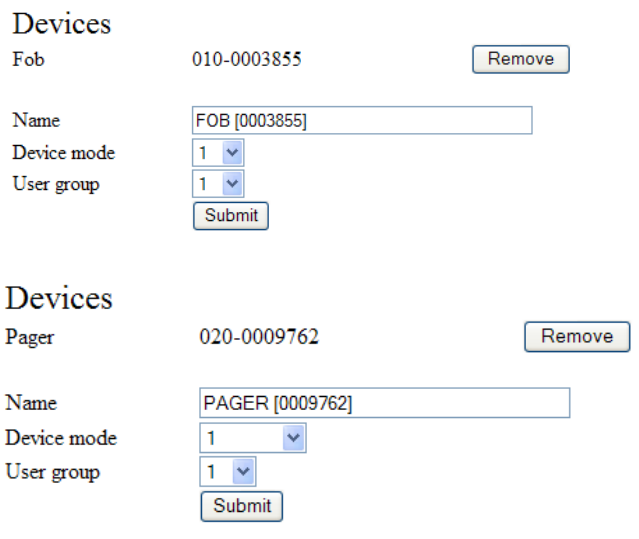
EkoTek System Installation and Configuration Manual
9261-8173 issue: 8 Page 56
© 2012 Multitone Electronics Plc
Device mode
Each repeater is allocated a device mode (1-32), with 1 as default. However,
the name for each device mode can be user configured, in which case different
options will appear in this menu. The device mode defines the behaviours of
hubs (radio channel, alarm raising ability, etc).
Zone
Fixed devices are allocated a zone number, allowing alarms from mobile
devices to be sent to different pager groups based on the hub or repeater (and
therefore zone) that the mobile device is connected to, and for directly raising
location alarms. Up to 16 zones are supported by the EkoTek system.
After selecting the device mode parameters, click ‘Submit’ to enter the
changes.
Pager and call fob
Name
The name of the pager or call fob may be changed, by entering a new name in
the box.
Device mode
Each pager and call fob is allocated a device mode. The device mode defines
the alarms and location reporting. See the ‘Device mode’ section (page 60).
User group
Select from the drop list, to set ‘User Group’ (1-16). Used to route alarms to
different pager groups.
After selecting the device mode parameters, click ‘Submit’ to enter the
changes.
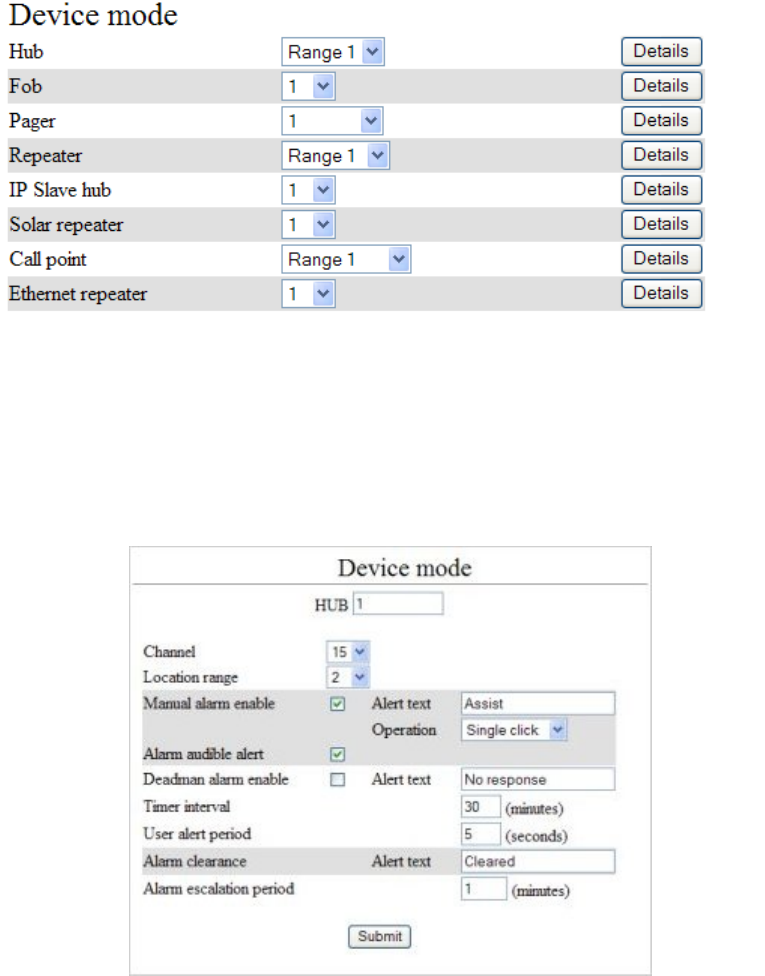
EkoTek System Installation and Configuration Manual
9261-8173 issue: 8 Page 57
© 2012 Multitone Electronics Plc
Device mode
This section allows changes to be made to device parameters. The initial page
presents a list of the different hardware types. A drop down menu allows
selection of a specific device mode for the hardware type (by default these are
1-32, but they can be renamed) and a ‘Details’ button, which goes to the
specific hardware device mode page.
Device mode – hub and IP slave hub
The hardware type is followed by the modifiable device mode name (default is
1-32).
Channel
Select from the drop down menu (1 -> 16) to set the radio channel to be used
by the hub. The default value of 15 should be used where possible. Different
channels should be used for each hub when installing overlapping systems.
See Appendix 4A: Overlapping system support (page 82).
Location range
Defines the range of the location signal from the hub. The default value is ‘2’
which gives an approximate range in indoor environments of 3 metres. A value
of ‘1’ gives the shortest range and ‘10’ the longest range. The range should not
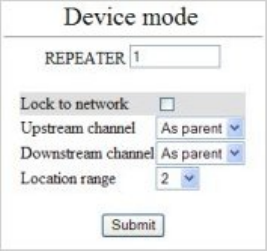
EkoTek System Installation and Configuration Manual
9261-8173 issue: 8 Page 58
© 2012 Multitone Electronics Plc
be set to high values in deployments where location signal penetration through
walls and floors is not desired.
Manual alarm enable
Sets whether the hub can raise manual alarms, i.e. by pressing the button.
Alert text
Modify text to define the message sent to pagers when the alarm is activated.
The default text is ‘Assist’.
Operation
Define how many button presses are required to trigger the manual alarm (1 or
2) selected by drop-down menu. Select either ‘Single click’ or ‘Double click’.
Alarm audible alert
Define whether device buzzer sounds when manual alarm is raised.
Dead man alarm enabled
Enable the dead man automatic alarm. This is raised if no input is received
from the user when prompted by the device.
Alert text
Modify text to define the message sent to pagers when this alarm is activated.
The default text is ‘No response’.
Timer interval
Sets the time (minutes) between user input prompts.
User alert period
Sets the length of time (seconds) that the buzzer sounds on the hub after the
user input prompt before the alarm is raised. If the user presses a button
during this time the alarm is not raised.
Alarm clearance alert text
Modifiable text appears in the message sent to pagers when any alarm for this
device is cleared. The default text is ‘Cleared’.
Alarm escalation period
If an active alarm is not cleared within this period of time (minutes), then the
device resends the alarm with an alternate escalation level.
After selecting the above parameters, click ‘Submit’ to enter the changes.
Device mode – repeater and solar repeater
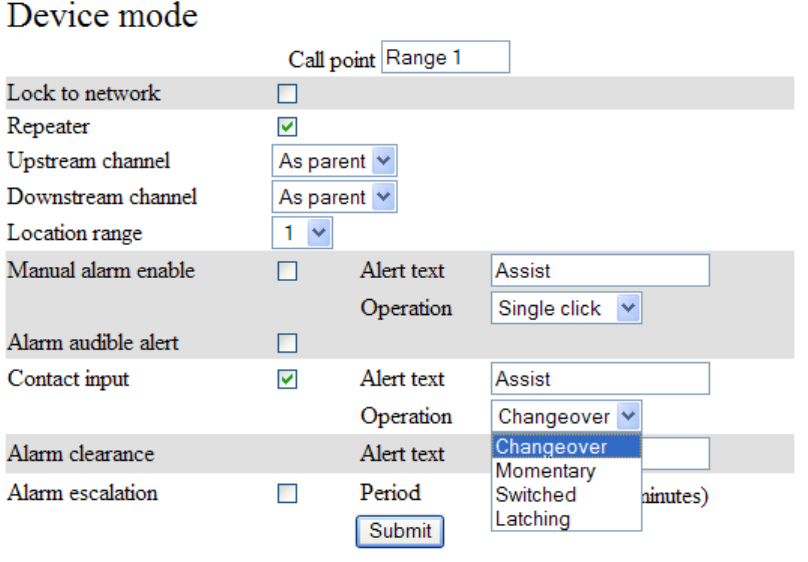
EkoTek System Installation and Configuration Manual
9261-8173 issue: 8 Page 59
© 2012 Multitone Electronics Plc
The device mode entry page shows the hardware type, followed by the
modifiable device mode name (defaults 1-32).
Lock to network
With Overlapping System Support (OSS), the repeaters must be locked to a
network if there are overlapping systems. To lock to a network check the ‘Lock
to network’ box. It is advised that ‘Lock to network’ should not be checked for
single standalone systems, and should not be checked for an overlapping
system until all devices have joined the network. For more details see
Appendix 4A: Overlapping system support (page 78).
Upstream channel/downstream channel
This applies to repeaters, solar repeaters and call points only. It is used to
determine the radio channel (1-16) of the repeater, selected via drop down
menu. In addition, the ‘As parent’ setting allows a repeater to use the same
radio channel as its parent device. This is the default mode of operation,
allowing for a self-organising radio network.
Location range
Defines the range of the location signal from the repeater. The default value is
‘2’ which gives an approximate range in indoor environments of 3m. A value of
‘1’ gives the shortest range and ‘10’ the longest range. The range should not
be set to high values in deployments where location signal penetration through
walls and floors is not desired.
After selecting the above parameters, click ‘Submit’ to enter the changes.
Device mode - call point
The device mode entry page shows the hardware type, followed by the
modifiable device mode name (defaults 1-32).

EkoTek System Installation and Configuration Manual
9261-8173 issue: 8 Page 60
© 2012 Multitone Electronics Plc
Lock to network, upstream channel, downstream channel and location
range
These are set in the same way as for the standard repeater.
Repeater
If this is set, the call point acts as a repeater as well.
Manual alarm enable
Sets whether the hub can raise manual alarms, i.e. by pressing the red button.
Alert text
Modify text to define the message sent to pagers when the alarm is activated.
Default text is ‘Assist’.
Operation
Define how many button presses are required to trigger the manual alarm (1 or
2) selected by drop-down menu. Select either ‘Single click’ or ‘Double click’.
Alarm audible alert
If enabled, the device buzzer sounds when manual alarm is raised:
Single pips – raising alarm
Double pips – raised alarm (the hub has sent out an alarm message)
Triple pips – alarm accepted by a pager user
Contact Input
Alert text
Modify text to define the message sent to pagers when the alarm is activated.
The default is ‘Red button’.
Operation
This sets the criteria for the operation of the alarm.
Changeover - pull cords that have a contact that changes state each time
the cord is pulled
Momentary - a momentary change of state on the 'raise' line input will
cause an alarm to be raised (e.g. contact open-closed-open, or closed-
open-closed). A second momentary change of state on the line will cause
the alarm to be cleared. The alarm can also be cleared using the clear line
or a long red button press. Really intended for connection to devices that
automatically raise and clear alarms
Switched - switch type input e.g. a thermostat
Latched – a momentary change of state on the 'raise' line input will cause
an alarm to be raised (e.g. contact open-closed-open, or closed-open-
closed). Any further change of state will have no action. The alarm must be
explicitly cleared by the clear line or red button. Allows the call point to be
used in nurse call or other situations where there is a risk of repeated
switch activation (ie. a patient repeatedly pulling on an emergency pull
cord)
Alarm escalation enabled
If the ‘Alarm escalation enable’ option is not selected, the call point will raise
the alarm only once and the audible alarm indication on the call point will
cancel after 30 seconds.
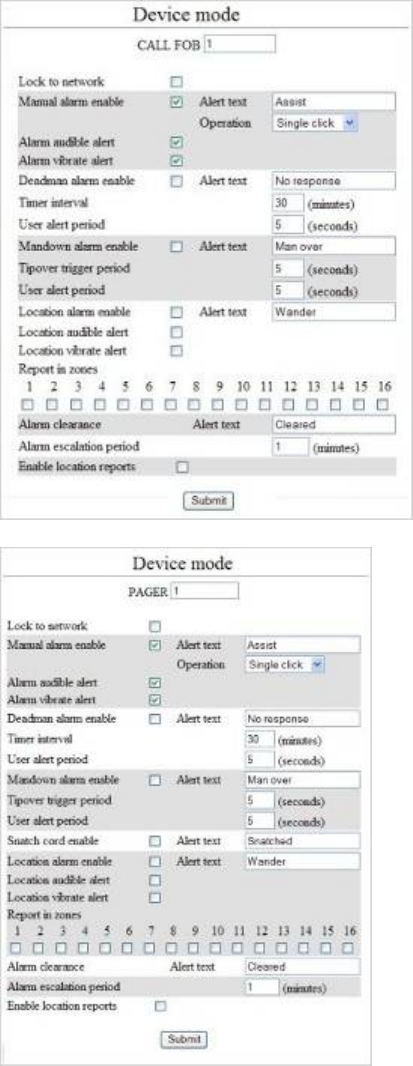
EkoTek System Installation and Configuration Manual
9261-8173 issue: 8 Page 61
© 2012 Multitone Electronics Plc
This is useful for non-critical alarms where the hassle of clearing the alarm
outweighs the benefits of repeating alarms with escalation.
When the audible alarm indication cancels after 30 seconds a ‘Cleared’
message is not sent.
When the audible alarm indication ends the alarm can be raised again.
Alarm escalation period
If an active alarm is not cleared within this period of time (minutes), the device
resends the alarm with an alternate escalation level.
Device mode - pager and call fob
EkoTek System Installation and Configuration Manual
9261-8173 issue: 8 Page 62
© 2012 Multitone Electronics Plc
The device mode entry page shows the hardware type, followed by the
modifiable device mode name (defaults 1-32). The device mode entry page
content for the pager and the call fob are the same except for ‘Snatch cord
enable’ and its corresponding alarm text, which are not present for call fobs.
Lock to network
If the pager or call fob is to be used exclusively on a single network then the
‘Lock to network’ should be checked. See Appendix 4A: Overlapping system
support (page 31).
Manual alarm enable
Sets whether the pager or call fob can raise manual alarms, i.e. by pressing the
button.
Alert
Modify text to define the message sent to pagers when the alarm is activated.
Defaults to ‘Assist’.
Operation
Define how many button presses are required to trigger the manual alarm (1 or
2) selected by drop-down menu. Select either ‘Single click’ or ‘Double click’.
Alarm audible alert
Define whether device buzzer sounds when manual alarm is raised.
Alarm vibrate alert
Defines whether the vibrate motor is activated when a manual alarm is raised.
Dead man alarm enabled
Enable the dead man automatic alarm. This is raised if no input is received
from the user when prompted by the device.
Alert text
Modify text to define the message sent to pagers when this alarm is activated.
The default text is ‘No response’.
Timer interval
Sets the time (minutes) between user input prompts being requested.
User alert period
This feature sets the length of time (seconds) that the buzzer sounds on the
hub after the user input prompt. If no entry from User then the alarm is raised, if
the user presses a button during this time then the alarm is not raised.
Man down alarm enable
Enable the tip-over switch automatic alarm. This is raised if the unit has been
moved away from an upright position for a defined period of time.
Alert text
Modifiable text appears in the message sent to pagers when this alarm is
activated. Default text is ‘Man over’.
EkoTek System Installation and Configuration Manual
9261-8173 issue: 8 Page 63
© 2012 Multitone Electronics Plc
Tip-over trigger period
Length of time a device must be moved away from upright, until the user
warning buzzer sounds (seconds).
User alert period
Length of time that the buzzer sounds on the device, without it being returned
to the upright position and the cancel button pressed, before the alarm is raised
(seconds).
Snatch cord
For pagers fitted with a snatch cord (later models only).
Snatch cord enabled
When enabled, the user will raise an alarm whenever the snatch cord on a
pager fitted with this device is removed. The alarm will be automatically
cleared when the snatch cord is reattached.
Note: For earlier pager models without the snatch cord option, or where the
blanking plug is used instead of the snatch cord, this feature should always be
disabled.
Alert text
Modifiable text appears in the message sent to pagers when this alarm is
activated. Default text is ‘Snatched’.
Location alarm enabled
Enable the location-based alarm. This is raised if the unit is moved to an area
covered by repeaters assigned to an unauthorised zone. Check the box to
enable this feature. Enter the text to be displayed when the alarm is triggered.
Location audible alert / vibrate alert
The mobile device beeper and vibrate functions can be enabled or disabled
when the alarm is raised, allowing either covert or normal alarm operation.
Check boxes to enable alert.
Report in zones
To select those zones where the alarm is to be raised, check the box
associated with that zone. If the pager or call fob enters an unauthorised
(checked) zone the location alarm will be raised. The location alarm will be
cancelled automatically if the pager or call fob re-enters an authorised
(unchecked) zone.
Alarm clearance alert text
Modifiable text appears in the message sent to pagers when any alarm for this
device is cleared. The default text is ‘Cleared’.
Alarm escalation period
If an active alarm is not cleared within this period of time (minutes), then the
device resends the alarm with an alternate escalation level.
After selecting the above parameters, click ‘Submit’ to enter the changes.
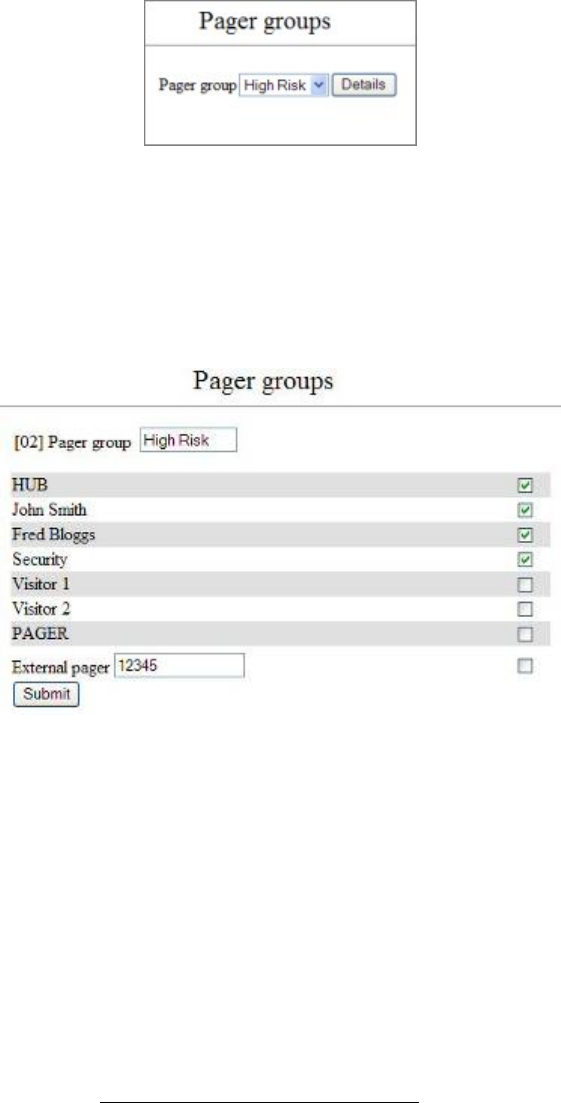
EkoTek System Installation and Configuration Manual
9261-8173 issue: 8 Page 64
© 2012 Multitone Electronics Plc
Pager groups
These pages are used to manage hubs and display pagers into groups.
Devices may appear in none, one or many pager groups. Each group is
restricted to 35 devices.
Pager group selection page
The list of 32 pager groups is given in a drop-down menu. By default these are
named 1-32. Each group can be assigned a name if required, using the pager
group entry page.
Click ‘Details’ to open the pager group entry page and set up a group.
Pager group entry page
Pager group
Enter text for the pager group name.
All the connected display equipped devices are listed (by name) and a
checkbox denoting membership to this group. Check the box to add the
devices to the group.
External pager
If connection is to be made to an external pager, enter the pager identifier into
the number field. This is the identifier sent via the ESPA/TAP output interface.
Check the box to add the external pager to the group.
Click ‘Submit’ to confirm the new pager group membership. If more than 35
devices are selected the changes will not be accepted.
Alert rules
The alert rules determine the target pager group for every alarm.

EkoTek System Installation and Configuration Manual
9261-8173 issue: 8 Page 65
© 2012 Multitone Electronics Plc
Alarms are routed according to the user group of the device raising the alert,
the location of the device when the alarm is raised (given by the zone of the
local repeater), the day-night setting of the system and whether it is an initial
alarm or an escalation of an existing alarm.
By default, no rules are defined and all alarms raised on-system will result in
messages being sent to display devices (and the external pager number) in the
pager group ONE.
The page operates in a number of modes, displaying the current rules table,
allowing new rules to be added and existing rules to be modified and deleted.
Creating alert rules ensures the right device is called at the right time instead of
only sending everything to PG.1.
If any rules have been entered a table is displayed, the top row of which
contains:
User group
Parameters set in the device entry. Groups 1 to 16.
Zone
Parameters set in the device entry. Zones 1 to 16.
Time
The day or night setting of the system. ‘D’=day, ‘N’=night.
Esc
The escalation level of the alarm. ‘R’=raised, ‘N’=normal.
A black square means that a particular group, zone, time of day or escalation
has been included in the rule. The end of the row is a button containing the
name of the pager group that is targeted by the rule. If there are more than 16
rules in the table, the header will be repeated after the last rule.
Edit mapping
Clicking the pager group name button at the end of the row causes the page to
be reloaded with modifiable rules; the selected rule will appear as a shaded row
and in place of the pager group name a ‘Remove’ button will appear. The
checkboxes are preloaded with the current rules settings. Change the rule
settings as required and then click ‘Submit’ to save the amendments.
Note: the EkoTek system can only send one paging message to an external
system as a result of an alarm being raised. If a combination of rules is entered
that would cause more than one message to be sent to an external system a
conflict is detected and the ‘Submit’ entry will be ignored until the conflict is
resolved.
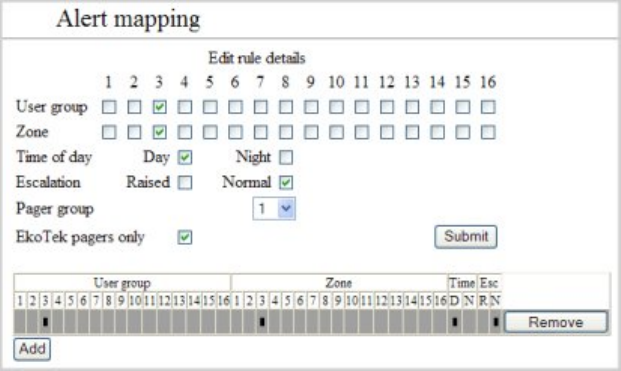
EkoTek System Installation and Configuration Manual
9261-8173 issue: 8 Page 66
© 2012 Multitone Electronics Plc
The following can be entered in the editing screen:
User group
Select the user group(s) always routed by this rule.
Zone
Select the zone(s) routed by this rule.
Time of day
Select the day and/or night settings of the shift mode.
Escalation
The escalation level of the alarm. ‘R’=raised, ‘N’=normal
Pager group
Select the target pager group.
EkoTek pagers only
When a rule has the ‘EkoTek pagers only’ option selected, messages using this
rule will not be sent to an external system. Rules with this option set are shown
as a shaded row in the alert mapping table, otherwise they are shown in white.
If ‘EkoTek pagers only’ is checked, a specified alarm event can be routed to
multiple pager groups, i.e. duplicate rules may be created allowing multiple
pager groups to be sent a message. In this mode external pagers will not be
contacted, so there is no conflict checking across alert maps.
Remove
Click the ‘Remove’ button to remove that rule from the table.
Add
Click the ‘Add’ button to enter a brand new rule; note that this option will only
appear if there are currently fewer than 32 rules.
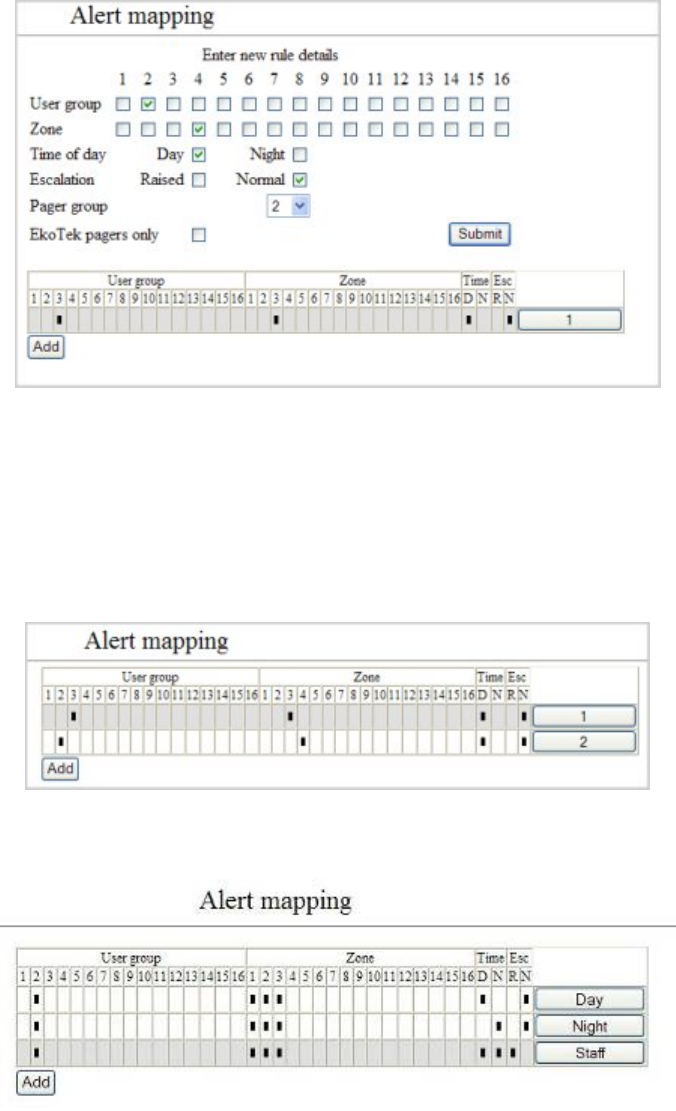
EkoTek System Installation and Configuration Manual
9261-8173 issue: 8 Page 67
© 2012 Multitone Electronics Plc
Clicking the ‘Add’ button will present a screen very similar to the edit rule mode;
the initial line is ‘Enter new rule details’ followed by the options and (clear)
checkboxes as for the editing screen.
Click ‘Submit’ to save the amendments. The new entry is checked for conflicts
in the same manner as in the editing screen. After a successful submission the
alert mapping page shows the new rule added to the list.
Example alert mapping table
The above example contains 3 rules:
1. The first rule routes all normal level alarms raised by devices with user
group 2, in zones 1,2 or 3, with the system running in ‘Day’ mode to pager
group ‘Day’.
2. The second rule routes all normal level alarms raised by devices with user
group 2, in zones 1,2 or 3, with the system running in ‘Night’ mode to pager
group ’Night’.
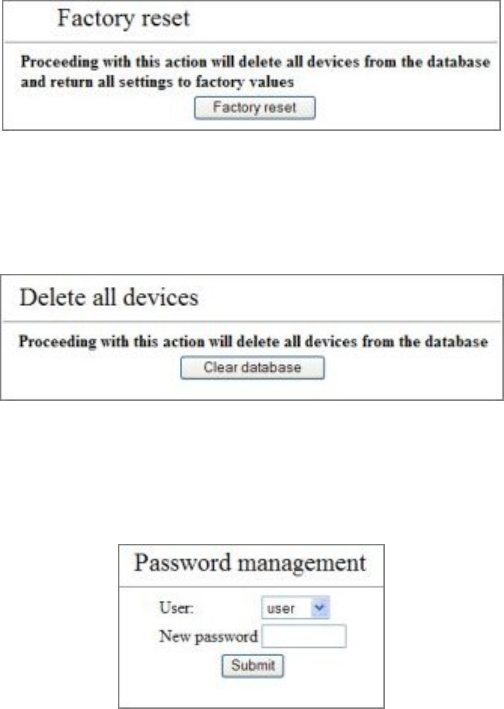
EkoTek System Installation and Configuration Manual
9261-8173 issue: 8 Page 68
© 2012 Multitone Electronics Plc
3. The third rule routes all escalated alarms raised by devices with user group
2, in zones 1,2 or 3, to pager group ‘Staff’ (the light grey highlight denotes
that only EkoTek pagers will be contacted in the group).
All other alarms will be routed by (default) to pager group 1.
Factory reset
Click the ‘Factory reset’ button to return the network to factory settings (all
devices deleted, IP addresses, passwords reset, etc).
Delete all devices
Click the ‘Clear database’ button to clear the database of all network devices,
but leave passwords, IP addresses, etc. as before.
Passwords
Change the system passwords.
‘User’ followed by a drop-down menu containing:
User
The User level allows access to all pages within the main and maintenance
menus and to the passwords page under the configuration menu (it can only
change the password for user).
Admin
The admin level allows access to all functions.
New password
Enter new password in the text input box. Click ‘Submit’ to enter the new
password.
‘User/admin password changed’ or ‘Password change failed’ will be displayed,
according to the outcome.
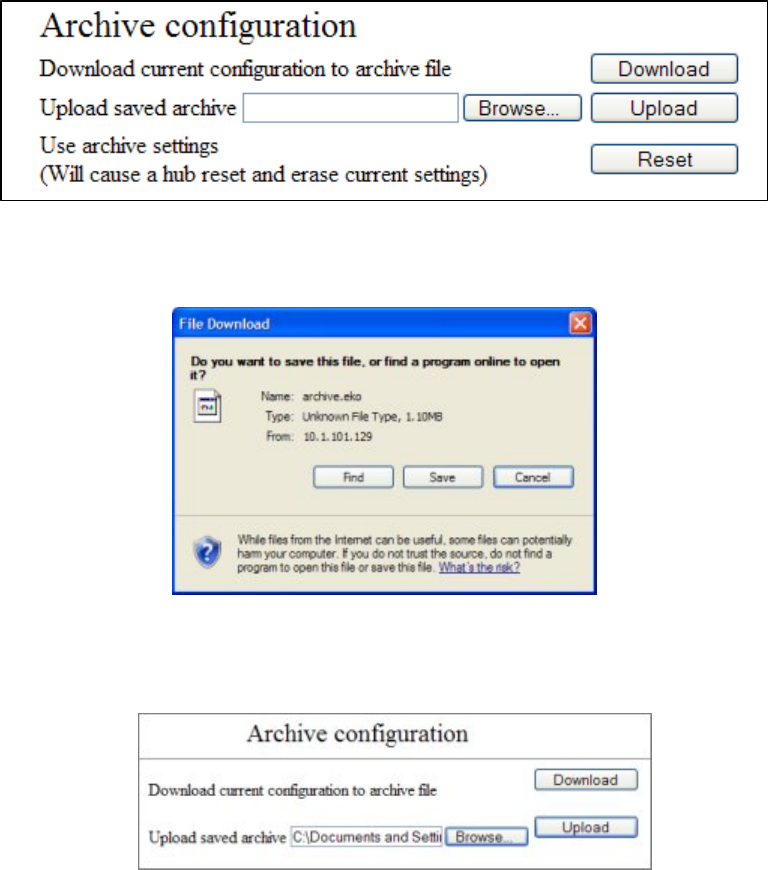
EkoTek System Installation and Configuration Manual
9261-8173 issue: 8 Page 69
© 2012 Multitone Electronics Plc
A password change failure may also be accompanied by: ‘New password must
be between 4 and 8 characters long’ if the password length is invalid, or ‘You
do not have permission to change this password’ if the user is logged in as user
and is attempting to change the admin password
Archive
This page is used to manage archiving and restoring the system configuration.
Download current configuration to archive file
Click the ‘Download’ button.
In the ‘File download’ pop-up box, click save and save the file to a location on
the PC.
Upload saved archive
Click the ‘Browse’ button and locate the saved archive.
Click the ‘Upload’ button and the configuration from the selected file is
transferred to the hub. This will take a few minutes. If there is a failure to
upload a saved configuration, this will result in the display of the following
message: ‘Error encountered uploading requested file’.
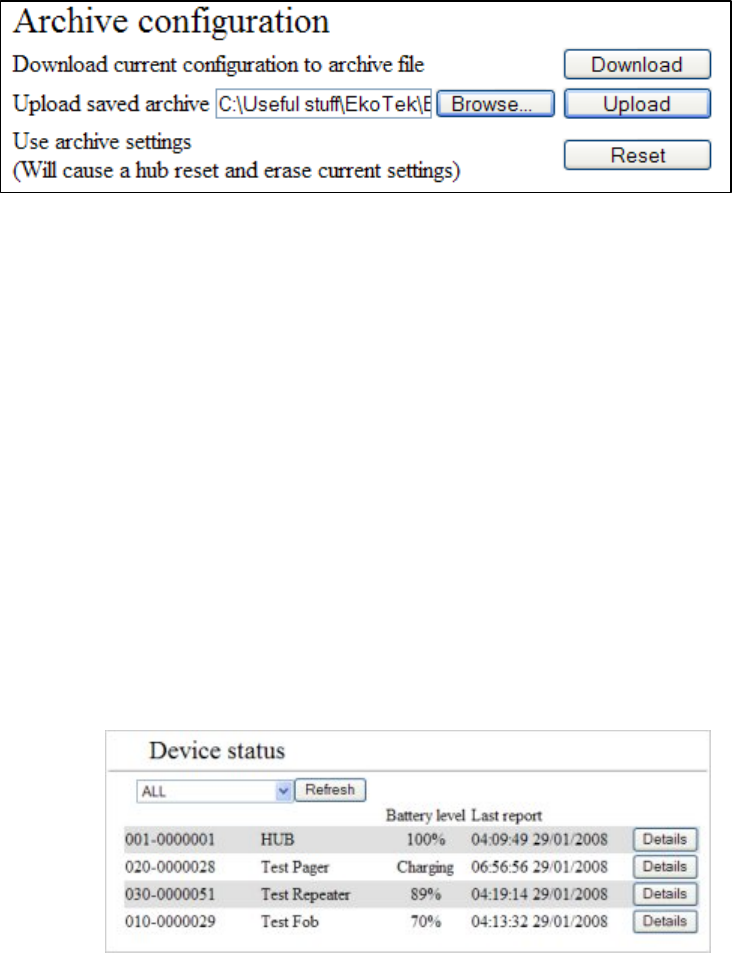
EkoTek System Installation and Configuration Manual
9261-8173 issue: 8 Page 70
© 2012 Multitone Electronics Plc
If a valid configuration has been uploaded to the hub, the following text is
displayed: ‘Use archive settings (will cause a hub reset and erase current
settings)’. The archived settings will not be applied until the hub is reset.
Click the reset button to change the hub configuration to the archived settings.
The process will take a few minutes, and is indicated by the normal separator in
the time field on the hub LCD screen being replaced by a flashing exclamation
mark. At this stage, trying to navigate within the EkoTek web pages can
interrupt the reset irreversibly. To avoid having to begin the upload process
again from the start, ensure that you monitor the hub LCD screen: when the
normal time separator returns, the process has completed. At this point the
web browser can be redirected to the new IP address of the hub.
13. Final checks
Connect a PC/Laptop to the hub via the customer’s Ethernet LAN connection.
Open the device status in the maintenance menu.
Check that all the repeaters are seen by the hub. If a repeater is not seen it may:
Be out of reach of a parent
Be faulty
Have a flat or disconnected battery
Investigate the cause using a survey pager. In cases where it is too far from the
nearest repeater to get a viable link a repeater may be needed to infill and complete
the mesh.
Click the details for each repeater and check the strength and quality of the link. If
the link looks marginal, remove the parent of that repeater from the network and see
if it will change to a different parent with a better link.
Seeing all repeaters may take some time with a large system.
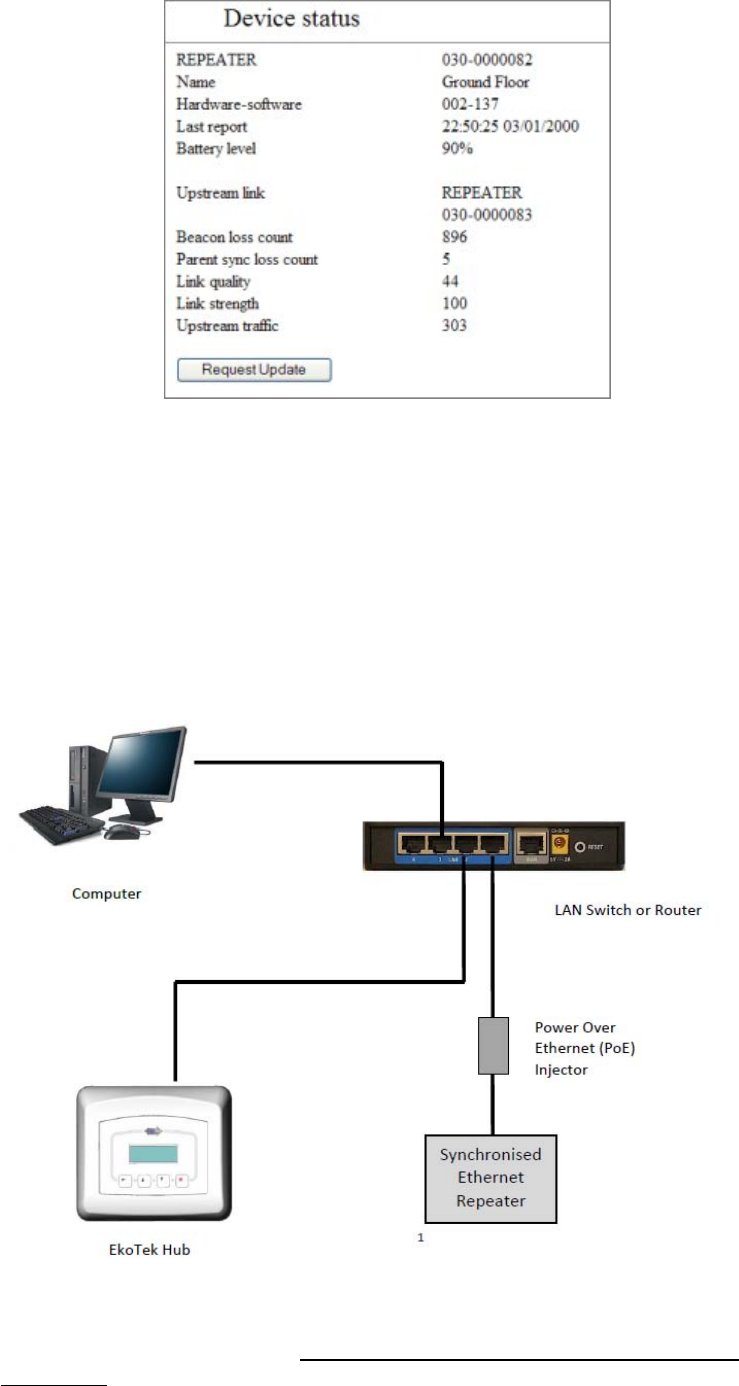
EkoTek System Installation and Configuration Manual
9261-8173 issue: 8 Page 71
© 2012 Multitone Electronics Plc
Register a pager and a call fob using auto-register and see if an alarm from the call
fob is received at the pager and that the response is sent to the fob on the network.
This will check correct configuration of alert rules and groups
This completes the installation.
14. Configuring SERs
Connecting to SER
The SER is connected to the hub via the customer’s LAN network using
standard CAT5 cable with an RJ45 connector. The SER is shown using a PoE
injector supplied as standard. (This LAN must be a solid guaranteed reliable
connection).
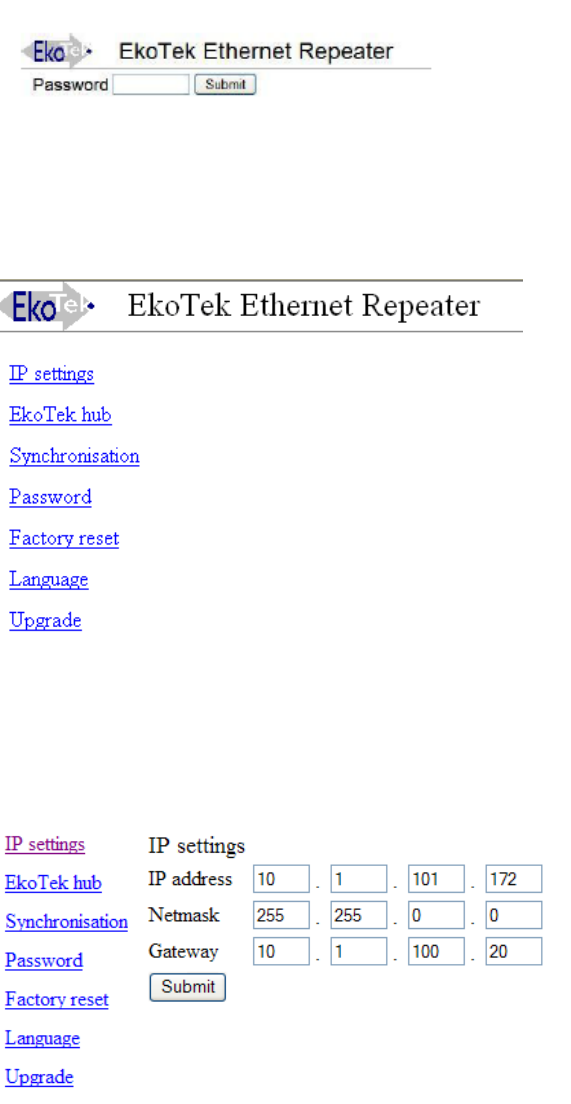
EkoTek System Installation and Configuration Manual
9261-8173 issue: 8 Page 72
© 2012 Multitone Electronics Plc
SER web pages
To configure the SER need access to the SER web pages. This is done using
any standard web browser such as Internet Explorer or Firefox. Open up the
browser and type in the default IP address (192.168.1.3). This will need to be
changed as all SERs must have a unique IP address within the customer range
of IP addresses.
SER home page
When the IP address is typed into browser the SER opens at home page and
immediately you’re prompted for password. (Default – blank).
Select ‘Submit’ and the following menu will be presented:
Configure SER IP address
Select the IP settings option and enter an address provided by the customer to
match their LAN Network, including mask and gateway settings.
IP settings must be consistent with HUB IP settings. Once details entered press
the ‘Submit’ button
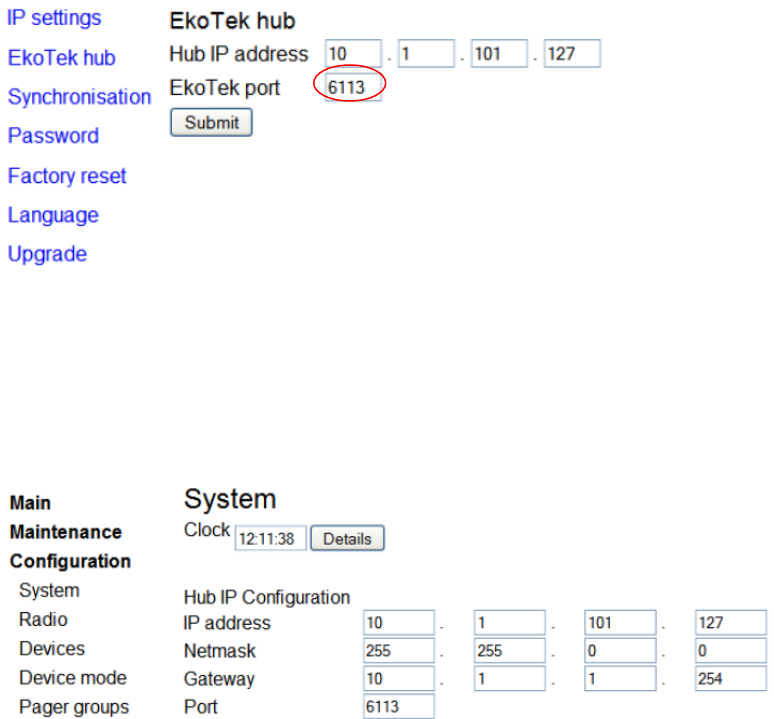
EkoTek System Installation and Configuration Manual
9261-8173 issue: 8 Page 73
© 2012 Multitone Electronics Plc
Setting HUB IP address on SER
Select EkoTek hub and then add the HUB’s IP address. The SER needs this
address in order for it to communicate with the hub. Note The port number
being used by the hub must be entered here (i.e 6113 in this example).
EkoTek hub - (system)
* Confirm settings in EkoTek hub match those shown in the SER.
*
*
*
*
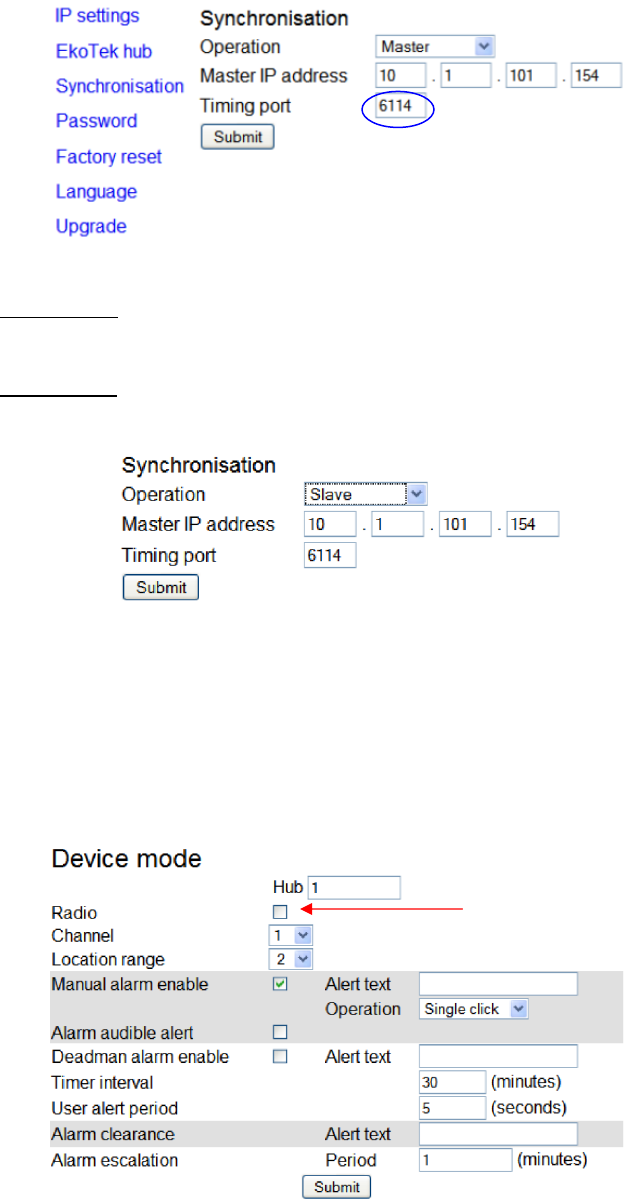
EkoTek System Installation and Configuration Manual
9261-8173 issue: 8 Page 74
© 2012 Multitone Electronics Plc
Synchronisation
In a non-SER EkoTek system then the hub provides synchronisation clock to all the
radio elements in the system. When SERs are added then one of the SERs will
become the system synchronisation MASTER and the remaining SERs will be set as
Slaves. There can only be one Master on any system.
Select synchronisation on one SER only to be the Master and all others will be slave.
For the Master SER the Master IP address can either be set to its own address
(10.1.101.154 in example) or (0.0.0.0).
For the Slave SERs the Master IP address must be set to the Master IP,
(10.1.101.54 in example).
Note:
1. The timing port is set to 6114 by default this normally works for most systems but
you need to confirm with customer’s IT department to make sure this port is not
used in their network.
2. The radio must be switched off at the hub when using SERs to provide
synchronisation for system.
Note: radio
unchecked
EkoTek System Installation and Configuration Manual
9261-8173 issue: 8 Page 75
© 2012 Multitone Electronics Plc
Appendix 1: Miscellaneous system messages
The following on-system messages are generated in addition to alert texts configured
using the web server interface.
1. Personal security messages
Accepted
Generated as a consequence of a pager accepting a raised alarm.
2. Pager response messages
Delivered
Accepted
Rejected
Denoting the delivery acknowledgement and appropriate user acceptance or
rejection.
3. Maintenance messages
Low battery
Generated when the battery level drops to 20%, will be re-generated for every
further 3% drop
Replace battery
Generated at 5% battery level and regenerated for every further drop.
Maintenance required
If a fixed device fails to report its status as scheduled on 4 consecutive
occasions (each report sent at 4.5 hour intervals) and if the device remains
persistently not reporting its status (i.e. a further 6 consecutive missed status
reports), a ‘Maintenance required’ message is generated.

EkoTek System Installation and Configuration Manual
9261-8173 issue: 8 Page 76
© 2012 Multitone Electronics Plc
Appendix 2: Specifications
Radio frequency 2405 – 2480MHz
Radio channels 16
Channel operating mode Fixed frequency, or frequency hopping
Maximum number of radio channels
simultaneously used per system 16
Radio power 10mW
Radio coding CDMA IEEE 802.15.4
Hub power AC-DC power adaptor
Hub backup batteries 3 x C cell NiMH rechargeable batteries
Repeater power 2 x D cell high capacity alkaline manganese
batteries
Pager power 1 x AAA cell high capacity alkaline
manganese, or NiMH rechargeable battery
Call fob power 1 x AAA cell high capacity alkaline
manganese, or NiMH rechargeable battery
Solar repeater power Proprietary battery pack
Mains powered repeater power 9.5-15V DC 15mA, with proprietary
rechargeable battery pack as backup
Charging rack AC-DC power adaptor
Call point 2 x D cell high capacity alkaline manganese
batteries
Mains powered call point 11 – 15v 25mA , with proprietary
rechargeable battery pack as backup
Maximum number of repeaters per
radio channels 90
Maximum number of pagers 127
Maximum number of pagers in a
pager group 35
Maximum number of devices per
system 500

EkoTek System Installation and Configuration Manual
9261-8173 issue: 8 Page 77
© 2012 Multitone Electronics Plc
Appendix 3: RS232 cable pin-outs for
connecting the modem to the hub
DB25 DCE DB9
2 TXD 3 Transmitted data
3 RXD 2 Received data
4 RTS 7 Request to send
5 CTS 8 Clear to send
6** DSR 6 Data set ready
7 GND 5 Signal ground
8 CD 1 Rec. line signal detector
**not connected
Link
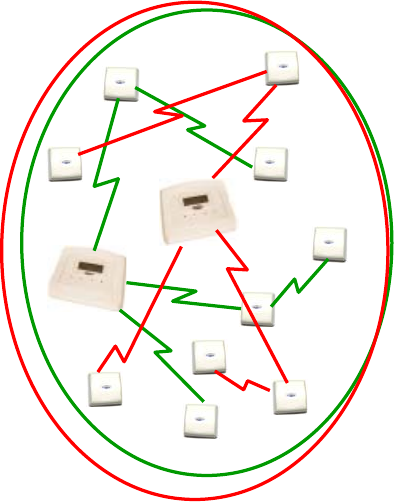
EkoTek System Installation and Configuration Manual
9261-8173 issue: 8 Page 78
© 2012 Multitone Electronics Plc
Appendix 4A: Overlapping system support
1. Overview
With complex network setups advice should always be sought from Multitone
Customer Services for assistance when planning this type of Installation.
Overlapping System Support (OSS) allows the mesh network radio footprint of
multiple hubs to overlap. This may be necessary, for example, where different
departments of an organisation have their own independent overlapping EkoTek
systems, or where there are fringe radio areas where the networks of multiple hubs
overlap.
Each network needs to be set with different network identifiers and radio channels.
Frequency hopping is forbidden with OSS.
2. Overlapping and mobile roaming systems
Two possible configurations for overlapping systems are supported.
A. Overlapping networks, where two networks substantially overlap at the same
location. This could be used to provide exclusive networks within the same area
each with its own population of pagers and call fobs.
B. Mobile roaming networks, where pagers and call fobs roam between the two
networks. In order that pagers and call fobs hand over upon entry to an adjacent
network it is important to design the networks to have minimum overlap to give a
clear indication of the zone where the pager or call fob is located. This also
Overlapping
networks
Network
A
Network
B
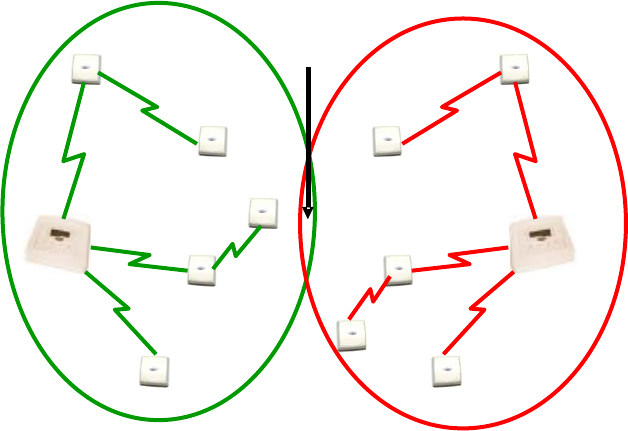
EkoTek System Installation and Configuration Manual
9261-8173 issue: 8 Page 79
© 2012 Multitone Electronics Plc
ensures that pagers and call fobs have time to lose contact with their existing
network and join their new network as they move between networks.
Network
B
Network A
Mobile roaming networks
Minimum
Overlap
EkoTek System Installation and Configuration Manual
9261-8173 issue: 8 Page 80
© 2012 Multitone Electronics Plc
Appendix 4B: Channel allocation with SER
1. Overview
The SERs is used in a customer network to provide synchronised radio coverage
over a larger site without having to resort to separate or overlapping systems. The
repeater operates in a similar way to a normal repeater except for the fact it is linked
back to the hub via the customer’s LAN. Each SER is allocated its own channels to
operate in its own area and link with the other repeaters in its vicinity, because it is
linked back via the LAN it does not need to be able to reach back to the hub via the
radio path.
This helps to reduce long chains of repeaters across a larger site and means set
channels can be used in different areas of a large site. This helps to ensure a stable
radio network. Linking between buildings can be done using SERs via LAN where
before a ‘chain of repeaters’ would have been required (this helps by reducing the
overall device count on the system).
With complex network setups advice should always be sought from Multitone
Customer Services for assistance when planning this type of installation.
EkoTek System Installation and Configuration Manual
9261-8173 issue: 8 Page 81
© 2012 Multitone Electronics Plc
Appendix 5: Remote logging protocol
1. Overview of logging
The remote logging facility can be used for real time recording and remote storage of
system events. Third parties are able to make use of the hub’s remote logging
output and external system input as a low level RS232 paging interface with higher
level application software creating more sophisticated functions. For example, an
application could be created to page staff members closest to the location where a
request for assistance is made from, or to display the location of an individual on a
graphical site plan, or to send an SMS message when a location alarm is raised.
The logging output from the hub supports output of the following message types:
Paging messages
Output each time a paging message is sent or responded to.
Location report
Output each time a device with location reporting enabled changes location.
Personal security alarm
Output when PS alarms are raised/cleared.
Maintenance message
Output when maintenance messages are raised e.g. low battery alarms from
repeaters.
Remote logging information is sent within a payload of SysLog formatted
messages. It is sent to UDP port 514 of the IP address specified on the system
configuration page. No check is made to ensure that the machine is present.
Remote debug logging
The hub also supports low-level message debug logging. This can be used by
Multitone for the diagnosis of network problems, but in a standard running
system should be set to ‘Off’. In order to differentiate between debug and
event logging different SysLog levels are used. Event logging is priority ‘info’
and debug logging is priority ‘debug’.
2. General formatting
Remote logging messages can be set to numeric only, text only or a combination of
numeric and text. These combinations allow the output to be easily human or
machine readable as required.
Tabs delimit the fields.
All fields are present in all messages, even if empty, unless no more fields are to be
filled in, where the line is then newline terminated.
Message always terminated by newline. Output can be off, numeric, text or numeric
and text.
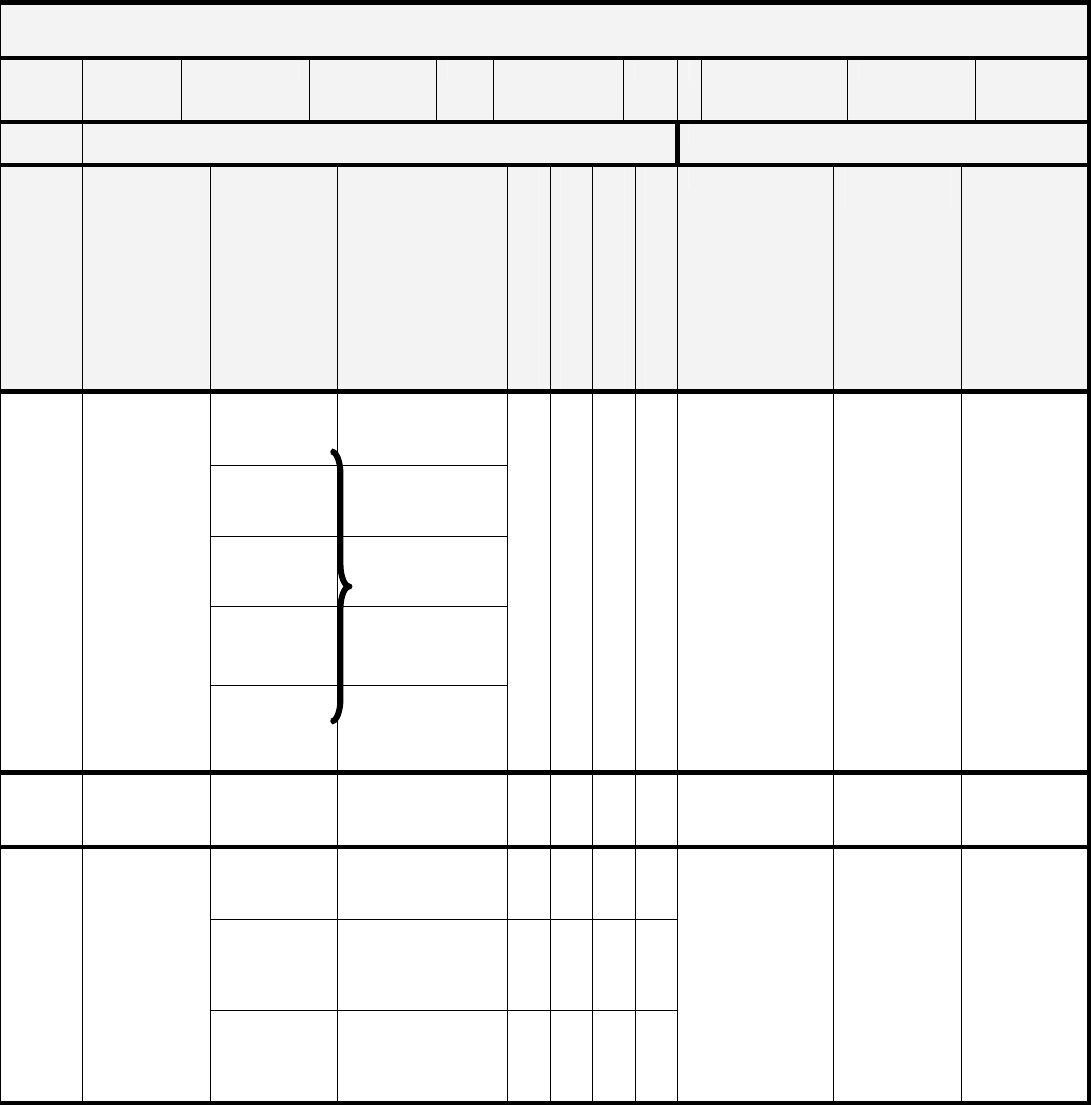
EkoTek System Installation and Configuration Manual
9261-8173 issue: 8 Page 82
© 2012 Multitone Electronics Plc
Logging protocol format
Field
no 1 2 3 4 5 6 78 9 10
Type Numeric Text
Name Log type Message
type
Reason code
Primary hardware
Primary serial no
Secondary hardware
Secondary serial no
Primary name Secondary
Name Message
1
Raised
1
Dead man
2
Accepted
2
Man down
3
Rejected
3
Manual
4
Cleared
4
Location
1 (PS)
Personal
security
5
Snatch cord
Device raising/
clearing alarm
Location of
device
raising alarm
OR
device
accepting/
rejecting
alarm
Personal
security alert
text
2 (LO)
Location
NA NA Device reporting
its location
Location
1
Low battery
NA
2
Replace
battery
NA
3 (MT)
Maintenance
3
Maintenance
required
NA
Device requiring
maintenance NA Maintenance
message
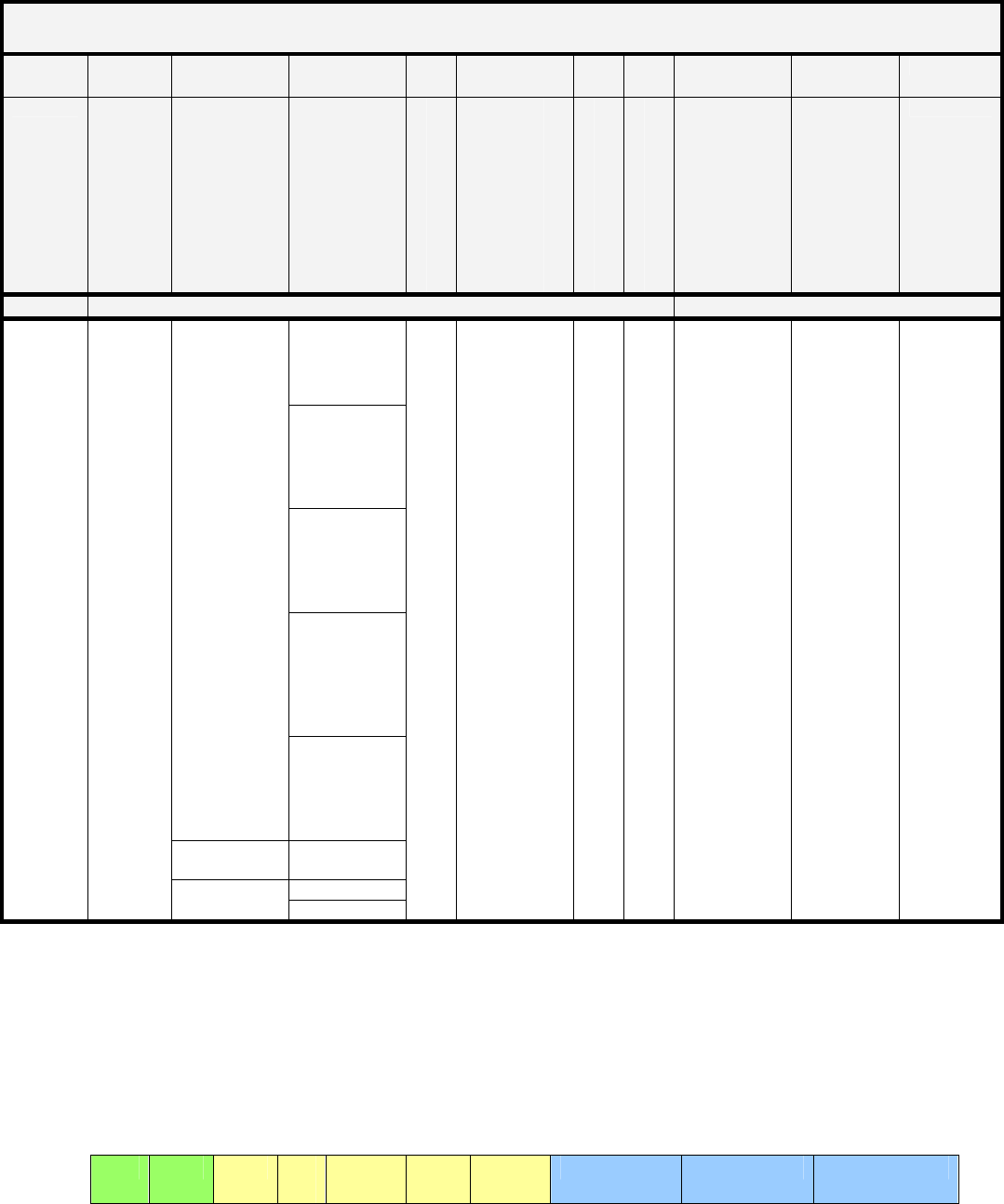
EkoTek System Installation and Configuration Manual
9261-8173 issue: 8 Page 83
© 2012 Multitone Electronics Plc
Logging protocol format
Field no 1 2 3 4 5 6 7 8 9 10
Name Log
type
Message
type
Reason
code
Primary hardware
Primary serial no
Secondary hardware
Secondary serial no
Primary
name
Secondary
name Message
Type Numeric Text
1
No response
required
2
Delivery
report
required
3
User
response
required
4
Delivery
report & user
response
required
1 Message
5
Externally
generated
message
2 Delivery
report
NA
1 Accept
4 (PG)
Paging
3 Message
response 2 Reject
Individually
addressed
destination
pager/
responding
pager
or
0,0 for
broadcast
or
0,pager
group
number for
pager group
NA NA
Blank for
broadcast,
or
pager group
name,
or
individual
pager name
NA
Message
text /
delivery
report /
user
response
3. Log examples
Key: Green: all SysLog messages; yellow: numeric output selected; blue: Text output
selected.
PS: Call fob raising manual alarm at reception repeater.
Note: The numbers in columns 4 to 7 are example serial number data. These will be
repeated throughout, but are omitted for clarity.
PS: Pager accepting (manual) alarm raised by call fob.
1 1 3 01
0 10000
39 030 00450
96 Call fob 1 Reception Assist
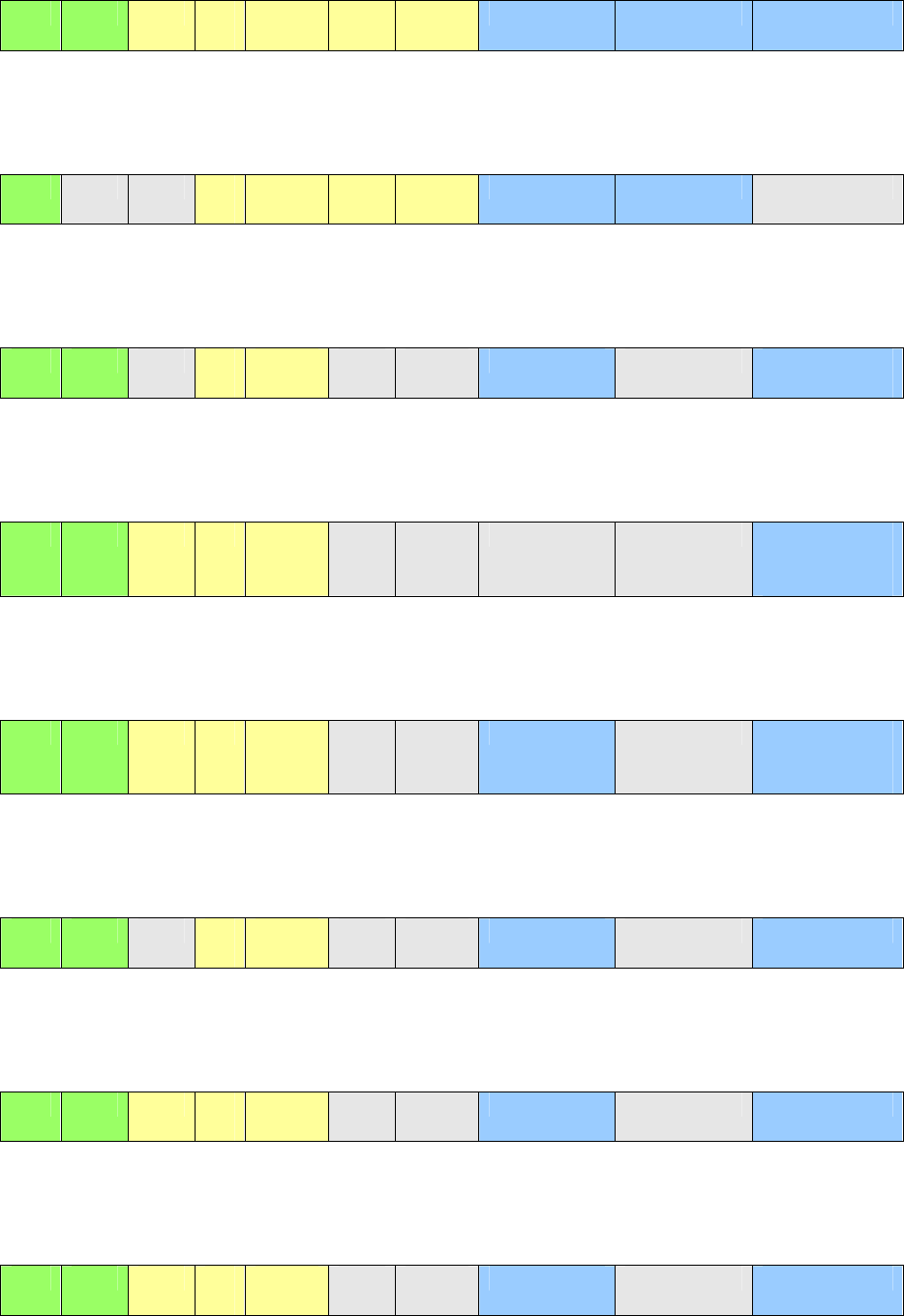
EkoTek System Installation and Configuration Manual
9261-8173 issue: 8 Page 84
© 2012 Multitone Electronics Plc
LO: Pager moving within range of hub.
MT: Repeater not reporting status.
PG: Message to all pagers, no response request.
PG: Message to pager group 1, response requested.
PG: Delivery report from pager.
PG: Accept response from pager.
PG: Reject response from pager.
1 2 3 01
0 10000
39 020 00983
54 Call fob 1 Pager 1 Accepted
1 02
0 00983
54 001 00230
76 Pager 1 The hub
3 1 03
0 00450
96 Reception Maintenance
required
4 1 1 0 0 The
message
sent
4 1 3 0 1 Group 1 The
message
sent
4 2 03
0 00450
96 Pager 1 Delivered
4 3 1 03
0 00450
96 Pager 1 Accepted
4 3 2 03
0 00450
96 Pager 1 Rejected
EkoTek System Installation and Configuration Manual
9261-8173 issue: 8 Page 85
© 2012 Multitone Electronics Plc
Appendix 6: External system connections
If the hub’s external system interface is to be used, a link is connected to the serial
port. The data rate should be set to the link speed (options are 300, 600, 1200,
2400, 4800 and 9600 bits per second). The data format and flow control should be
set to match that of the receiving device (options are 7 bit even parity or 8 bit no
parity with 1 or 2 stop bits). Messages will be truncated to 138 characters for TAP
messages and 128 characters for ESPA messages.
Only a single selection from those below can be made on the hub; bidirectional
paging operation has limited support by using Port A for Output and Port B as an
Input.
Options are: port A
ESPA input (maximum 138 characters). Note that 128 characters are defined by
the standard
ESPA output (maximum 101 characters, because only alarms are sent via this
interface). Note that 128 characters are defined by the standard
TAP input (maximum 138 characters)
TAP output (maximum 101 characters, because only alarms are sent via this
interface)
Options are: Port B
ESPA input (maximum 138 characters). Note that 128 characters are defined by
the standard
TAP input (maximum 138 characters)
Incoming pager messages are addressed as follows:
0 = all pagers
1-32 = pager group
HHHNNNNNNN for individual pagers where HHH = hardware type and NNNNNNN =
serial number.
Note: ESPA and TAP protocols do not have standardised third party implementations
– a test with third party equipment is necessary.
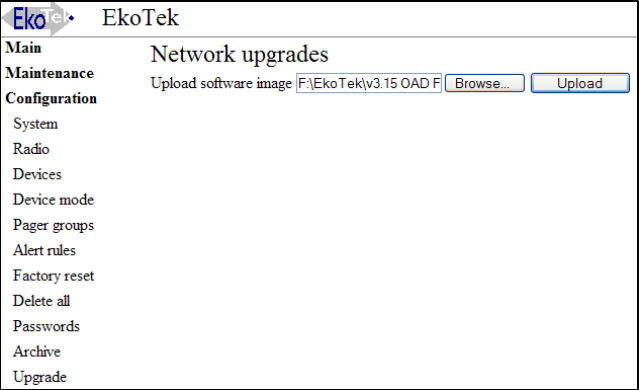
EkoTek System Installation and Configuration Manual
9261-8173 issue: 8 Page 86
© 2012 Multitone Electronics Plc
Appendix 7: Over the Air upgrade
Overview
From release v3.08 it became possible to upgrade all non-display devices “Over the
Air” (OTA). This is only available for “non-display” devices which include repeater,
call point, fob, solar repeater and the mains variants.
A software image for each variant is uploaded to the hub and this is then broadcast
from the hub. The process takes approximately 3 hours to deliver the update and the
devices reset to activate the new software at their next report time (approx. 4.5 hour
period).
An upgrade page was added to the configuration section to allow the Over the Air
download function to be used.
Upgrade Process
Before commencing a download it is important to check the battery level of the
devices to be updated. If the battery level is below 10% then the device will ignore an
update.
If the battery is between 10 - 25% the update will be collected but not become active
until the battery is replaced.
Above 25% and the update will become active as explained above, this is to ensure
the device does not lose power in the middle of an upgrade. If this were to happen it
would then need a manual upgrade to recover.
From the web browser select Configuration -> Upgrade
It will then be necessary to ‘browse’ to where the update file has been stored on your
PC/Laptop or USB stick. (ie) 040_R18.ota, current files for a call point. Having
selected this file the next step is to click on ‘Upload’ and wait for the file to be
uploaded to the hub.
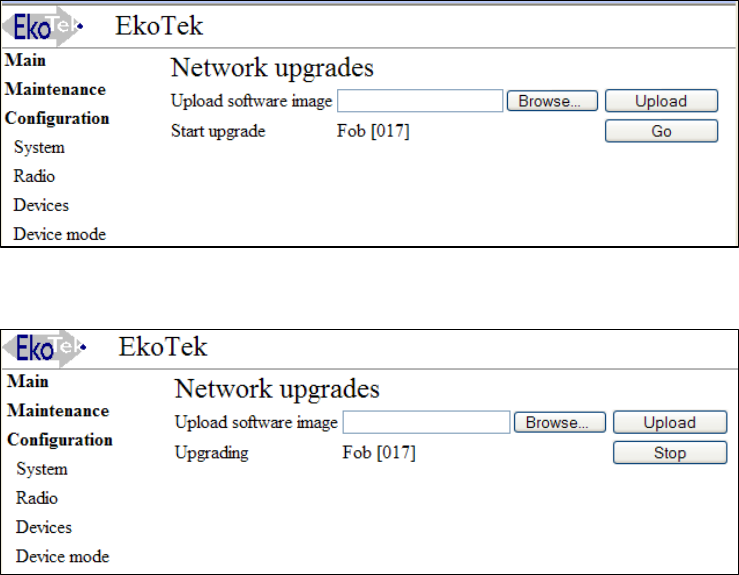
EkoTek System Installation and Configuration Manual
9261-8173 issue: 8 Page 87
© 2012 Multitone Electronics Plc
The ‘Go’ button will appear and identify which device the software is for once the
software is loaded on the hub, Now click on ‘Go’ and the upgrade to fob devices in
this example will commence.
As the upload commences OTA the following screen will appear:
The ‘Go’ button has been replaced by a ‘Stop’ button. Clicking on this button will stop
the OTA download of this file.
The hub will send the update during quiet periods. Time therefore to update will
depend on the size of the file but equally on how busy the system is.
Typically for a Repeater it will take about 3 hrs to download OTA. When it is
downloading the upgrade page shows a “Stop” button. When the download is
completed the page will show a “Go” on the button again. When a device has
received an update it does not activate it immediately but waits until its next
scheduled report time.
The report times are staggered so there is no sudden rush of messages at one
instant in time. This will also help reduce disruption to the system, as devices drop off
to update software before rejoining, keeping it to a minimum.
This means in a large system from the start of a repeater download to the last
repeater switching over to new software this time could be about 7.5 hrs.
This process needs to be done for each type of non-display device on the system
that needs to be updated. You can start the next device type when the current one
says “Go” on the upgrade button. (About 3hrs between devices).
A successful upgrade can be checked by selecting Maintenance -> Device Status ->
Device -> Details screen.

EkoTek System Installation and Configuration Manual
9261-8173 issue: 8 Page 88
© 2012 Multitone Electronics Plc
Revision history and related documentation
1. Revision history
Issue Date Author Revision
1 June 2007 M Windett Initial Document
2 30.08.07 R Robertson Production Issue
3 January 2008 M Windett Update for System Release 3 Sub Release 1
4 July 2008 M Windett Update for System Release 3 Sub Release 2
5 August 2008 D Neale Corrections and addition of new products
6 18.06.09 Gooding Latest Base and revise the drill diameter
7 03.11.09 D Neale Added mains powered repeater
8 13.01.12 D.Simpson Review Document & Update
2. Related documentation
Title Part Number
EkoTek Pager User Guide 9261-8275
EkoTek Hub User Guide 9261-8276
EkoTek Call Fob User Guide 9261-8277
EkoTek Call Fob Quick Instructions 9261-8311
EkoTek Pager Quick Instructions 9261-8312
EkoTek Hub Help Files (HTML) 4761-8313
Multitone Electronics plc
Multitone House
Shortwood Copse Lane
Kempshott
Basingstoke
Hampshire
RG23 7NL, UK
Document number: 9261-8173